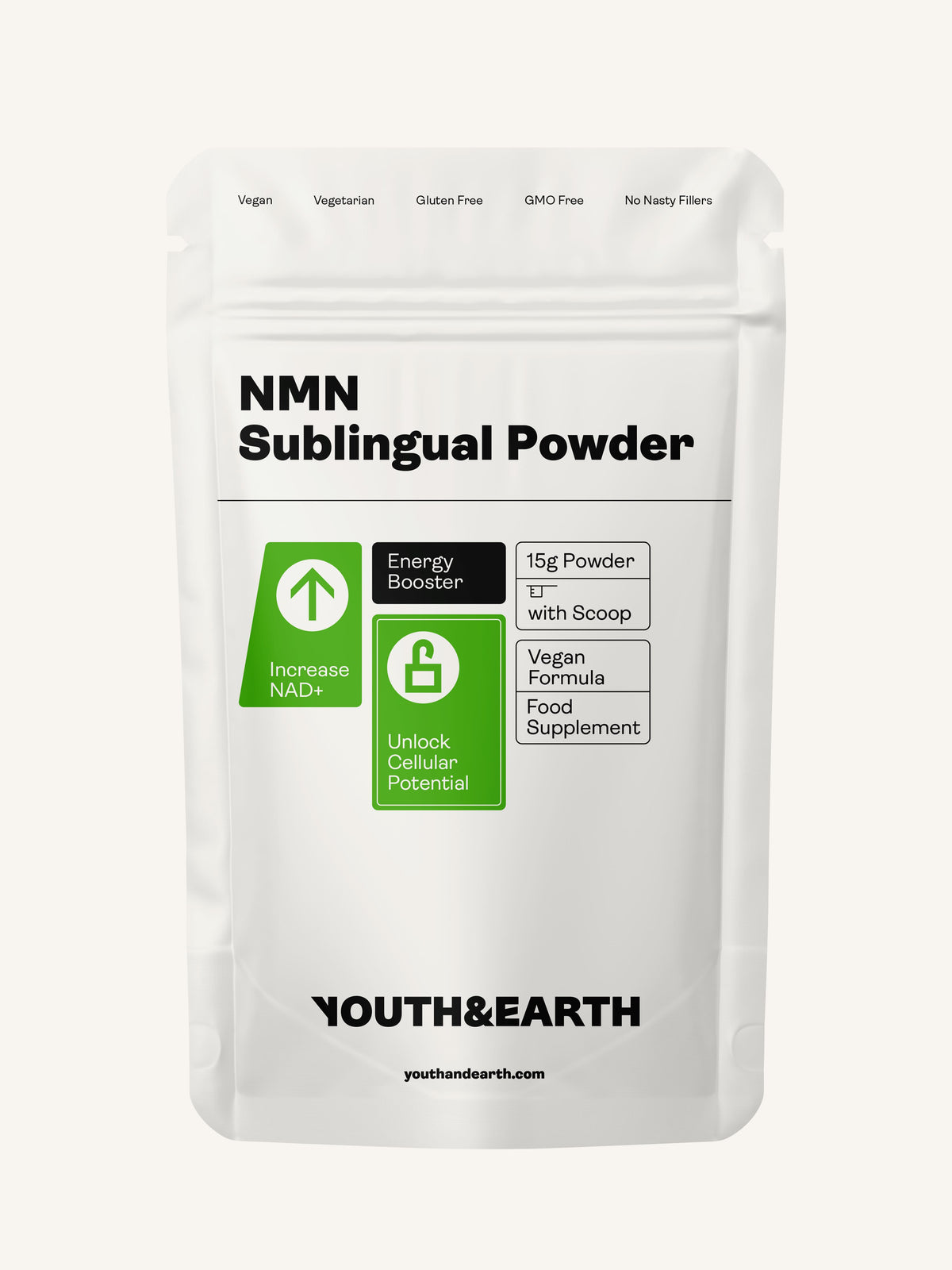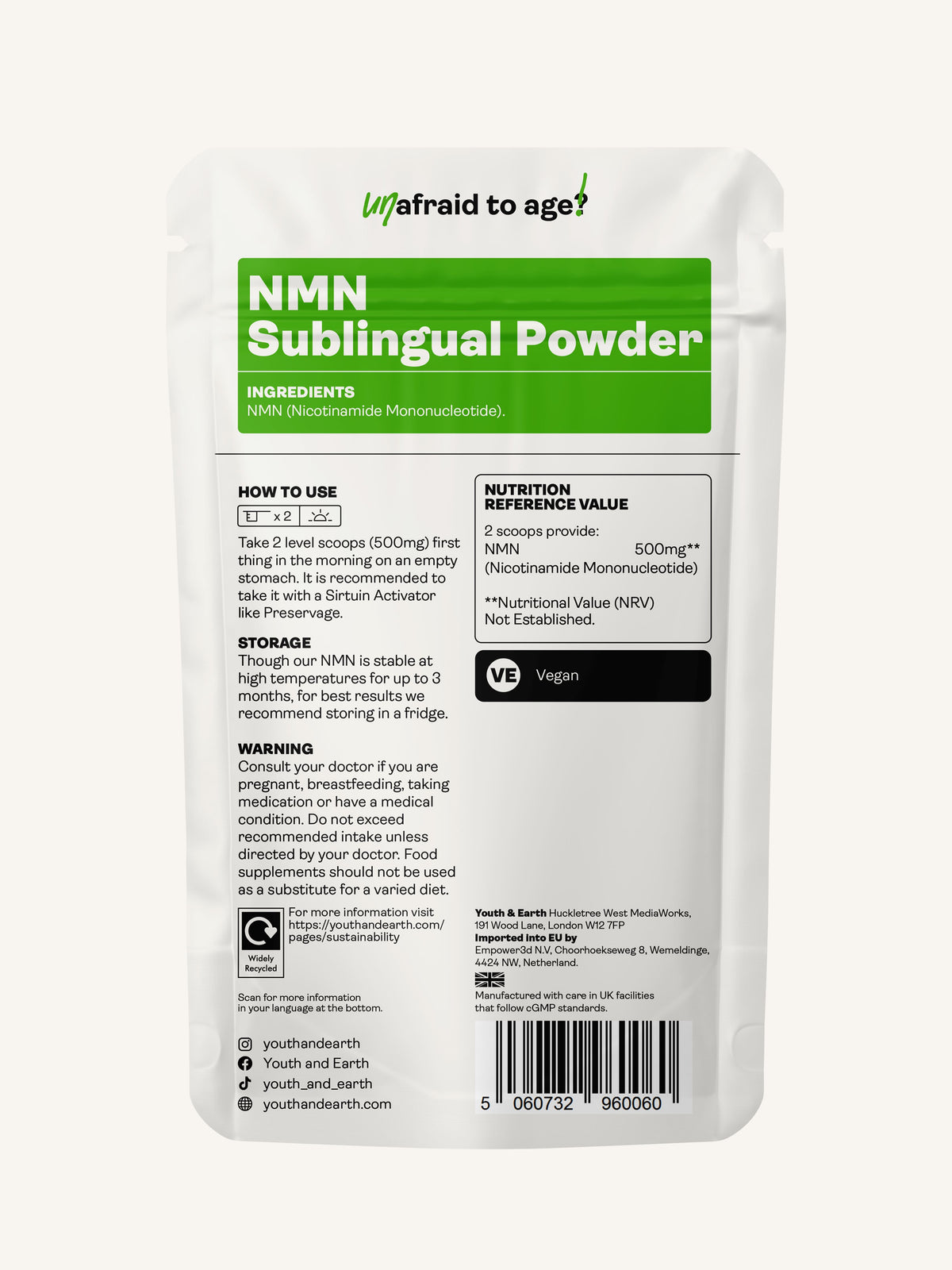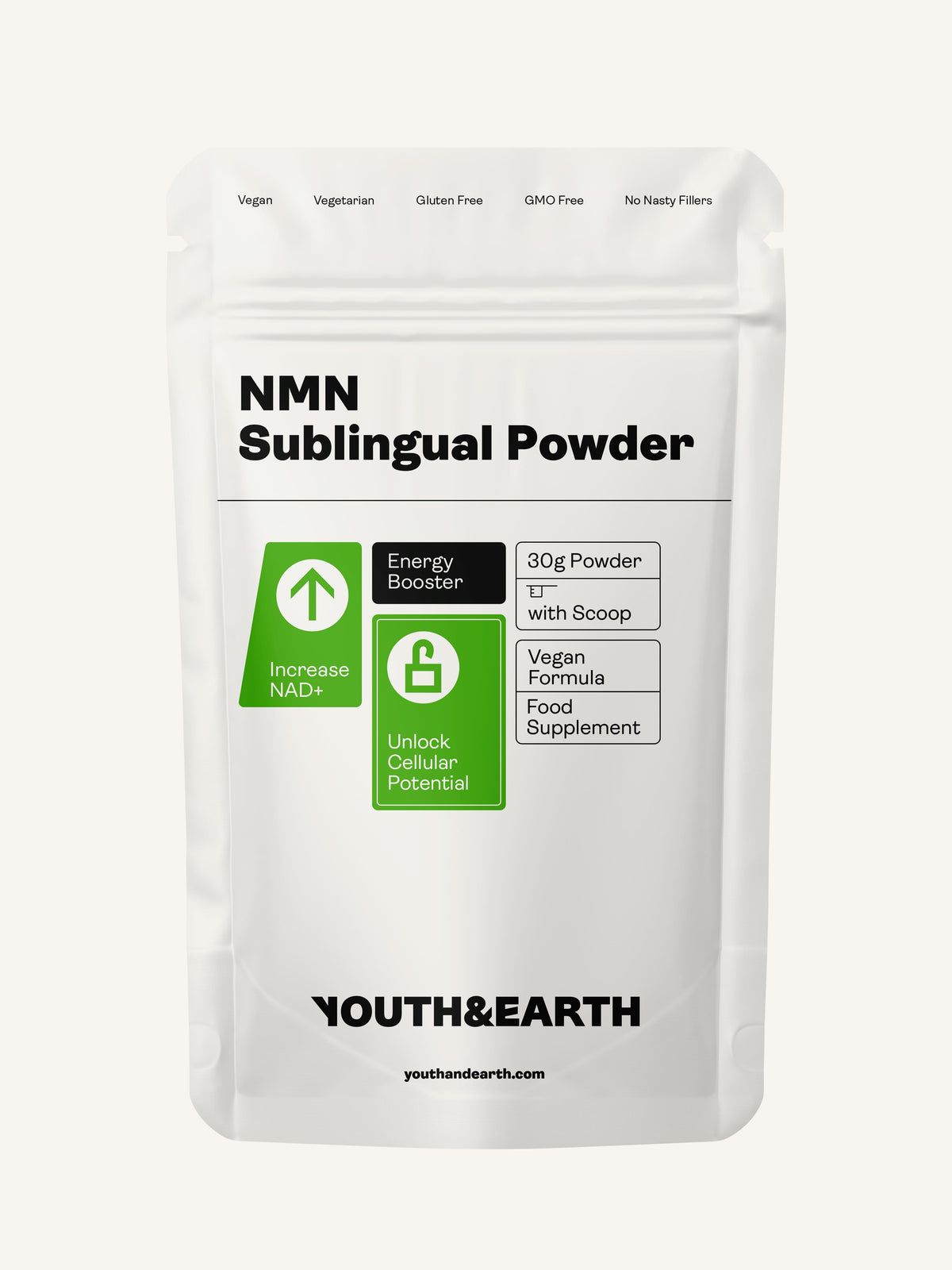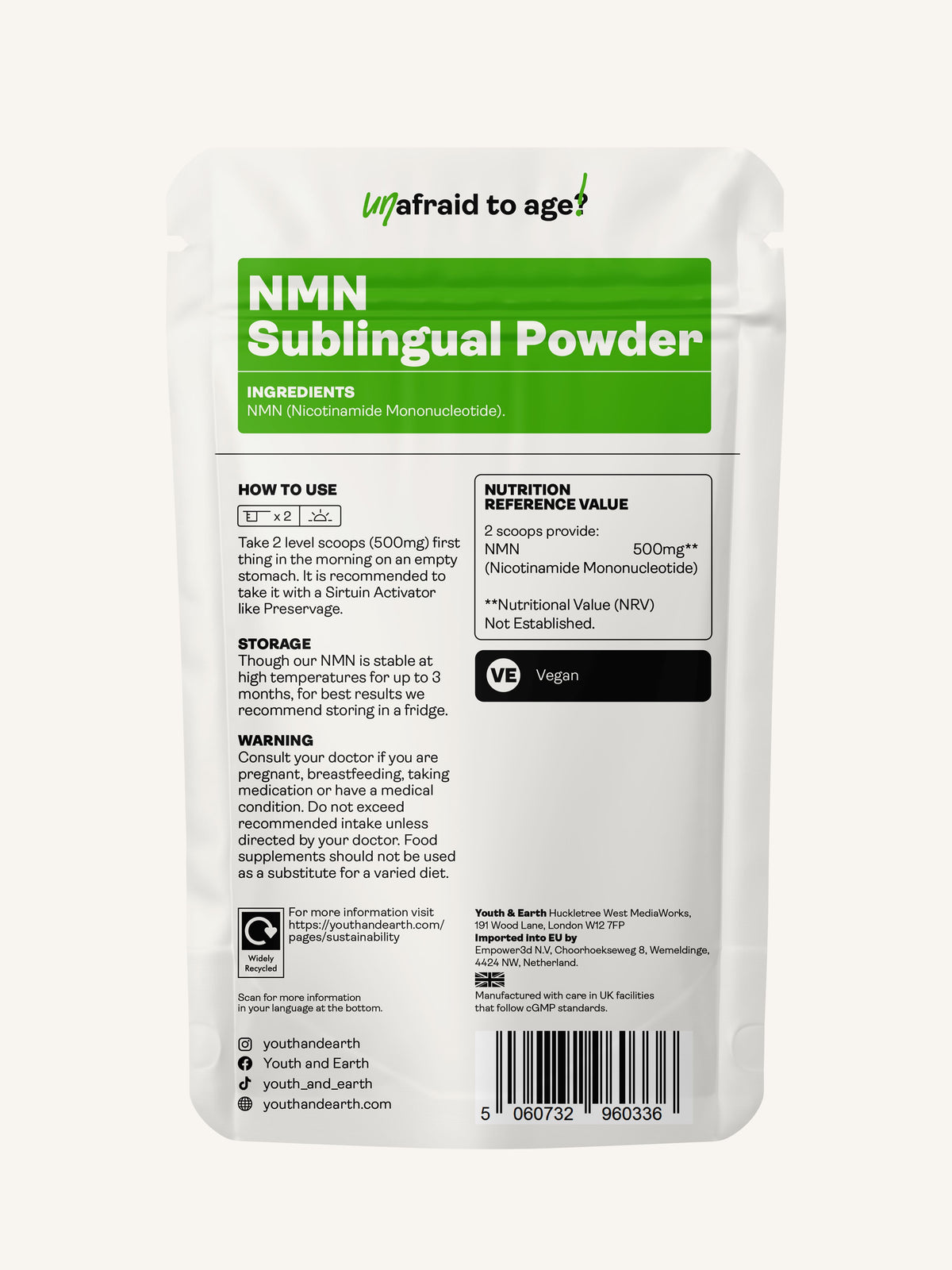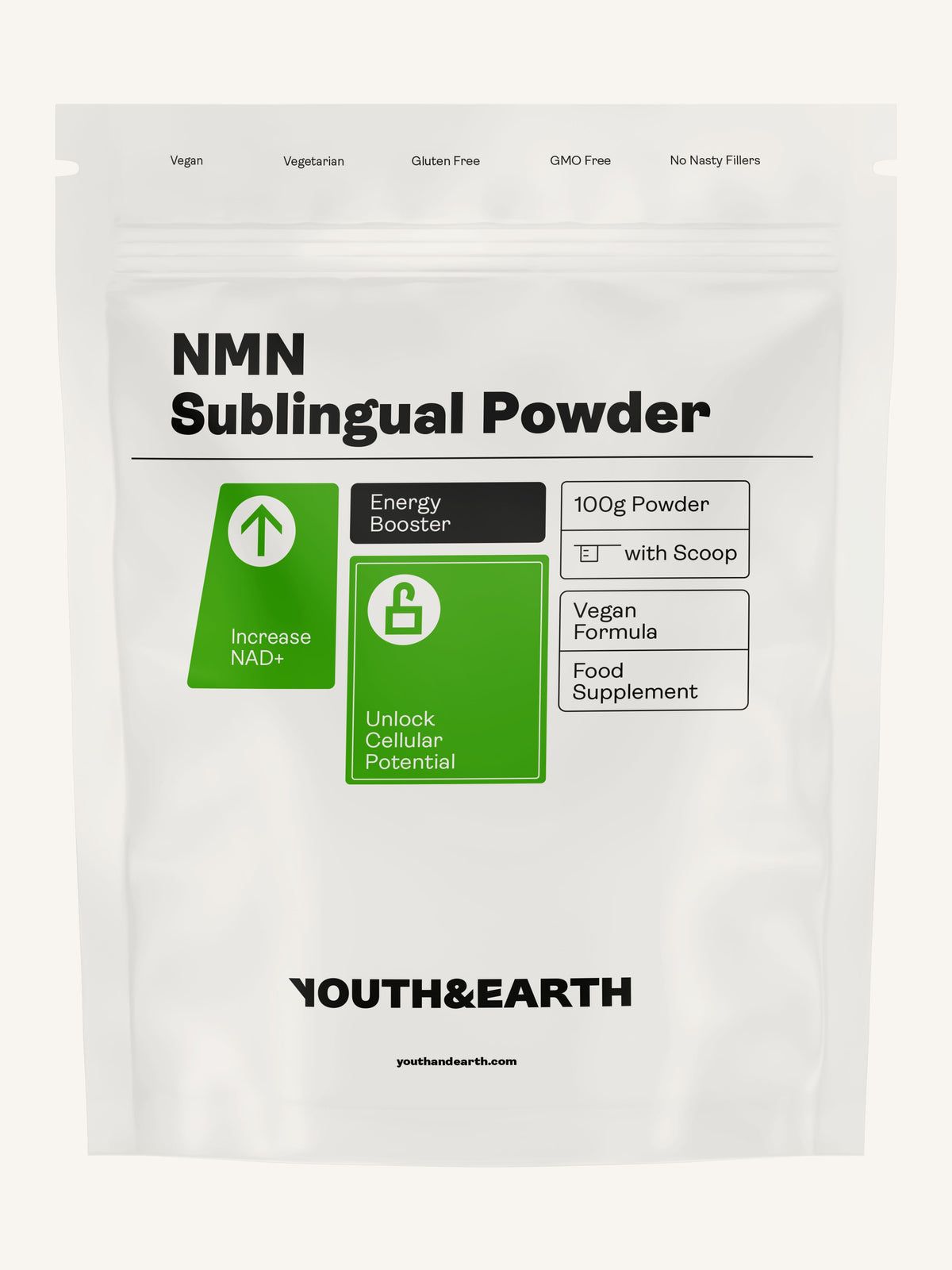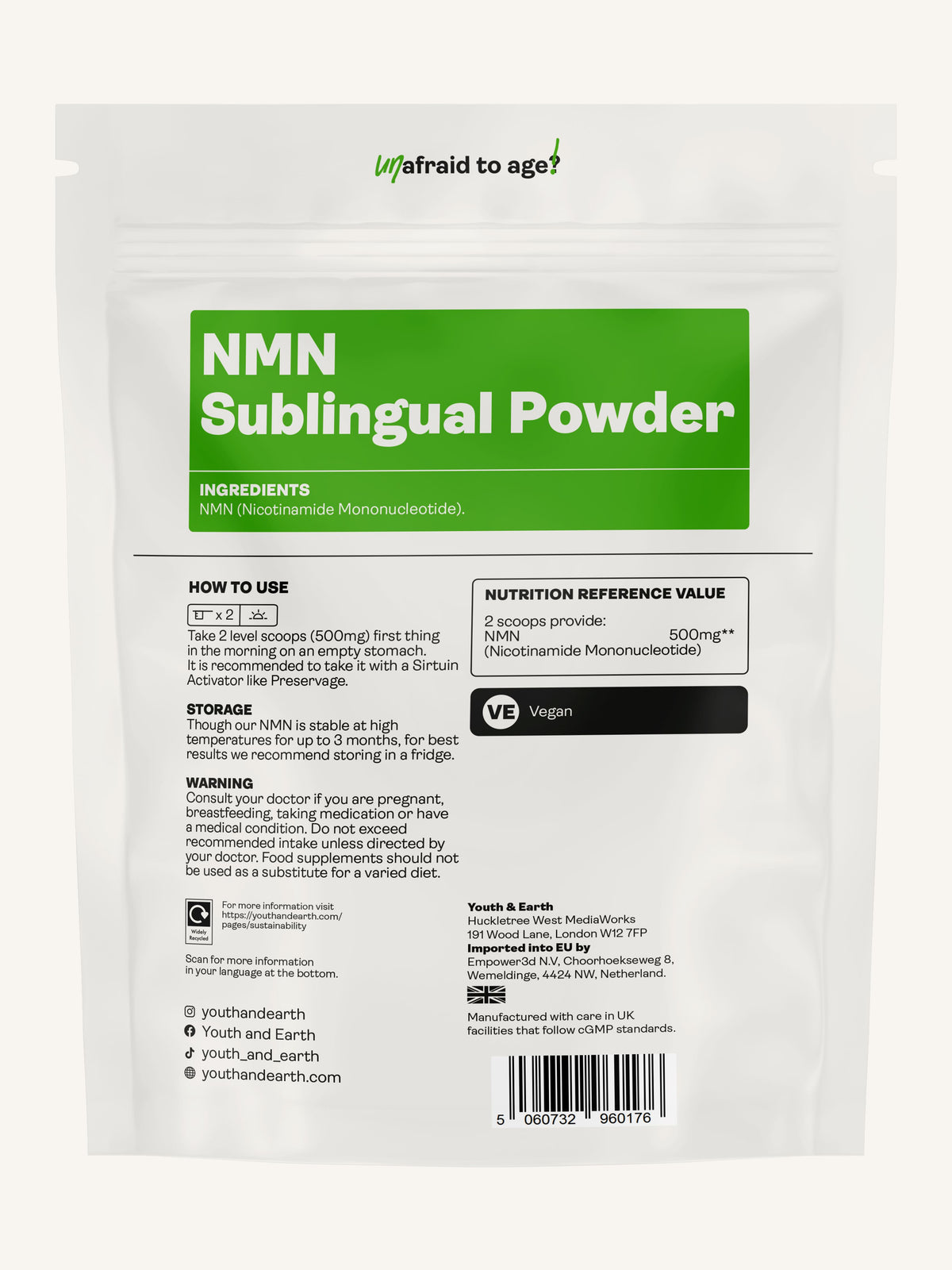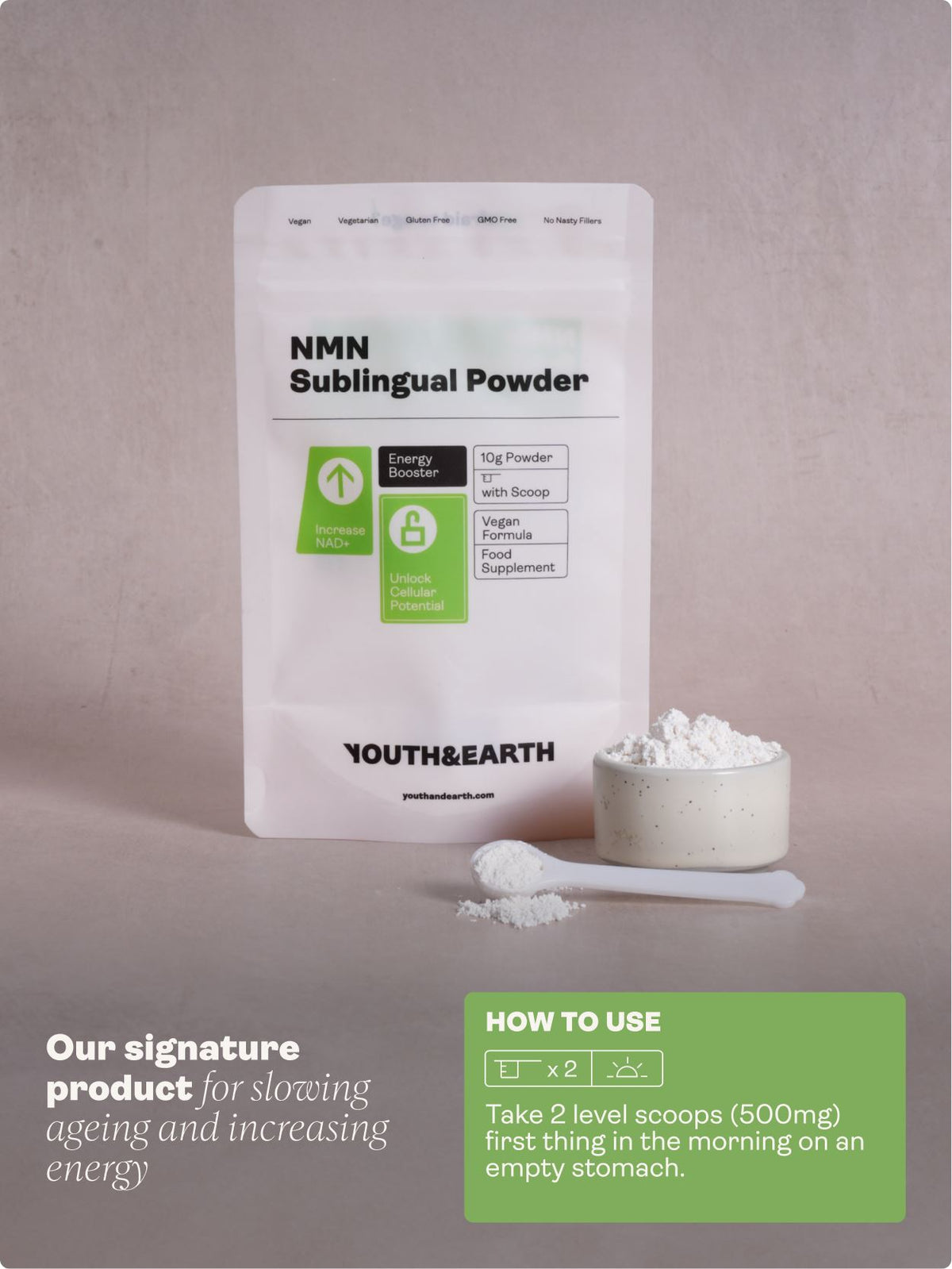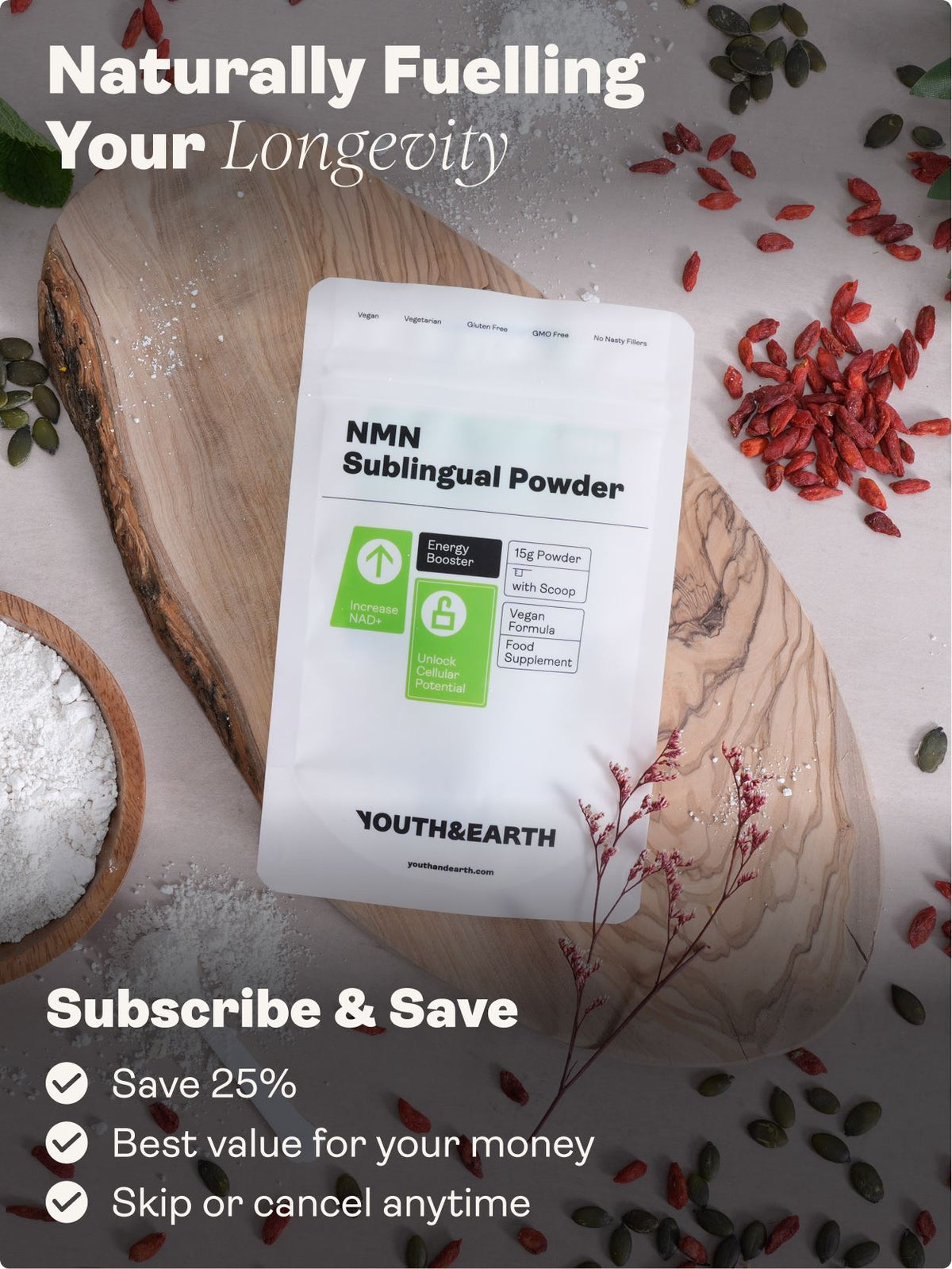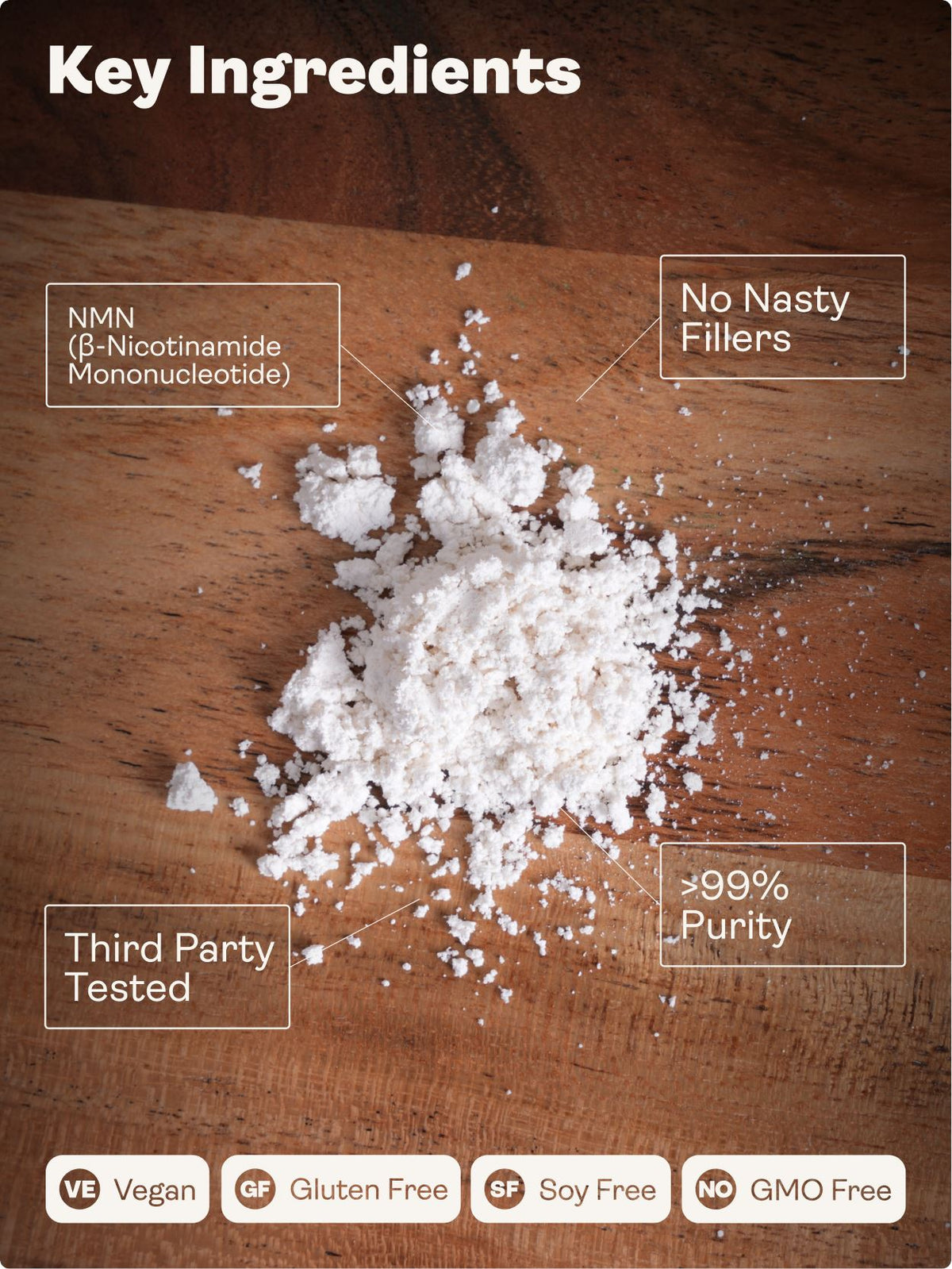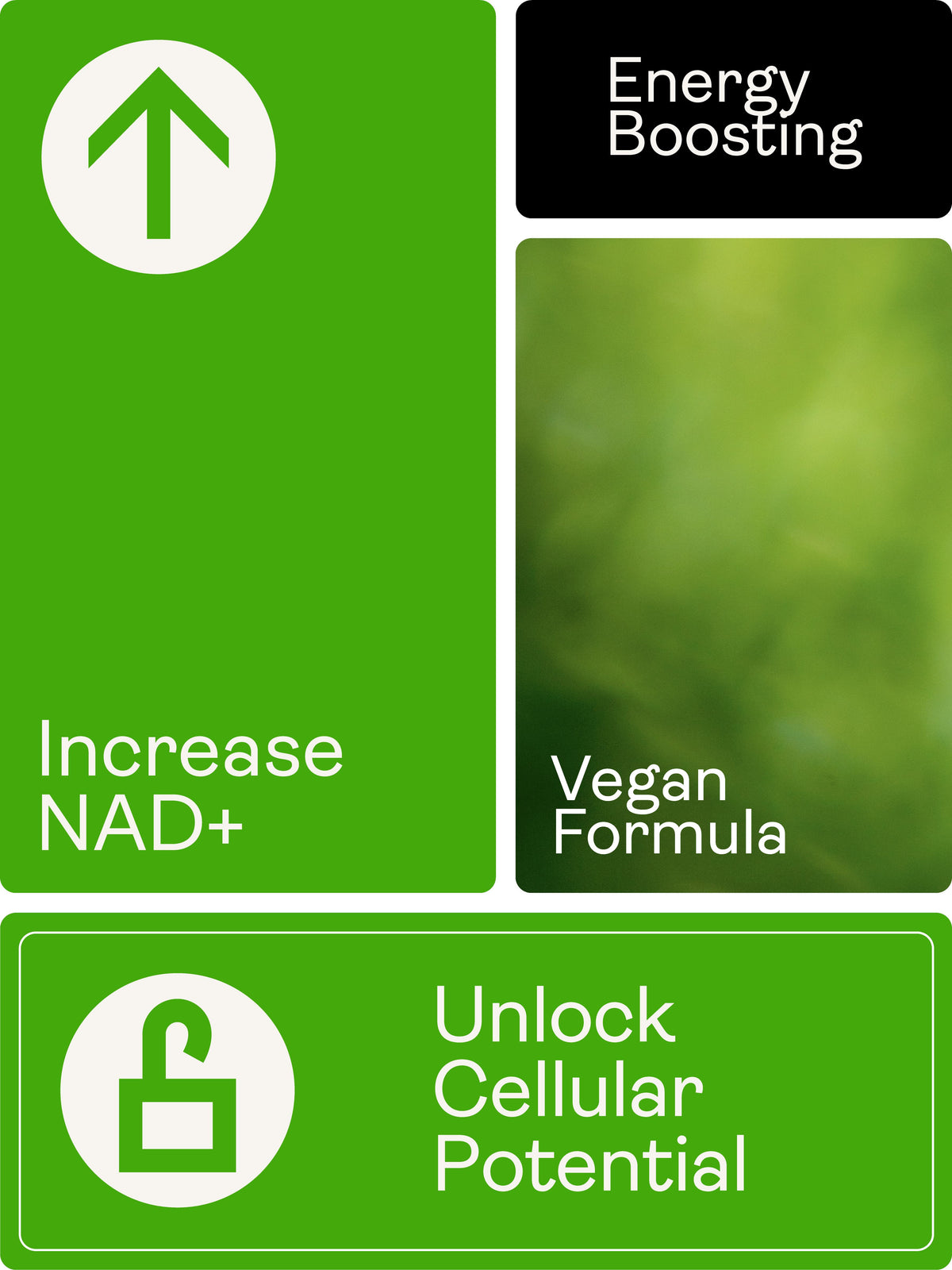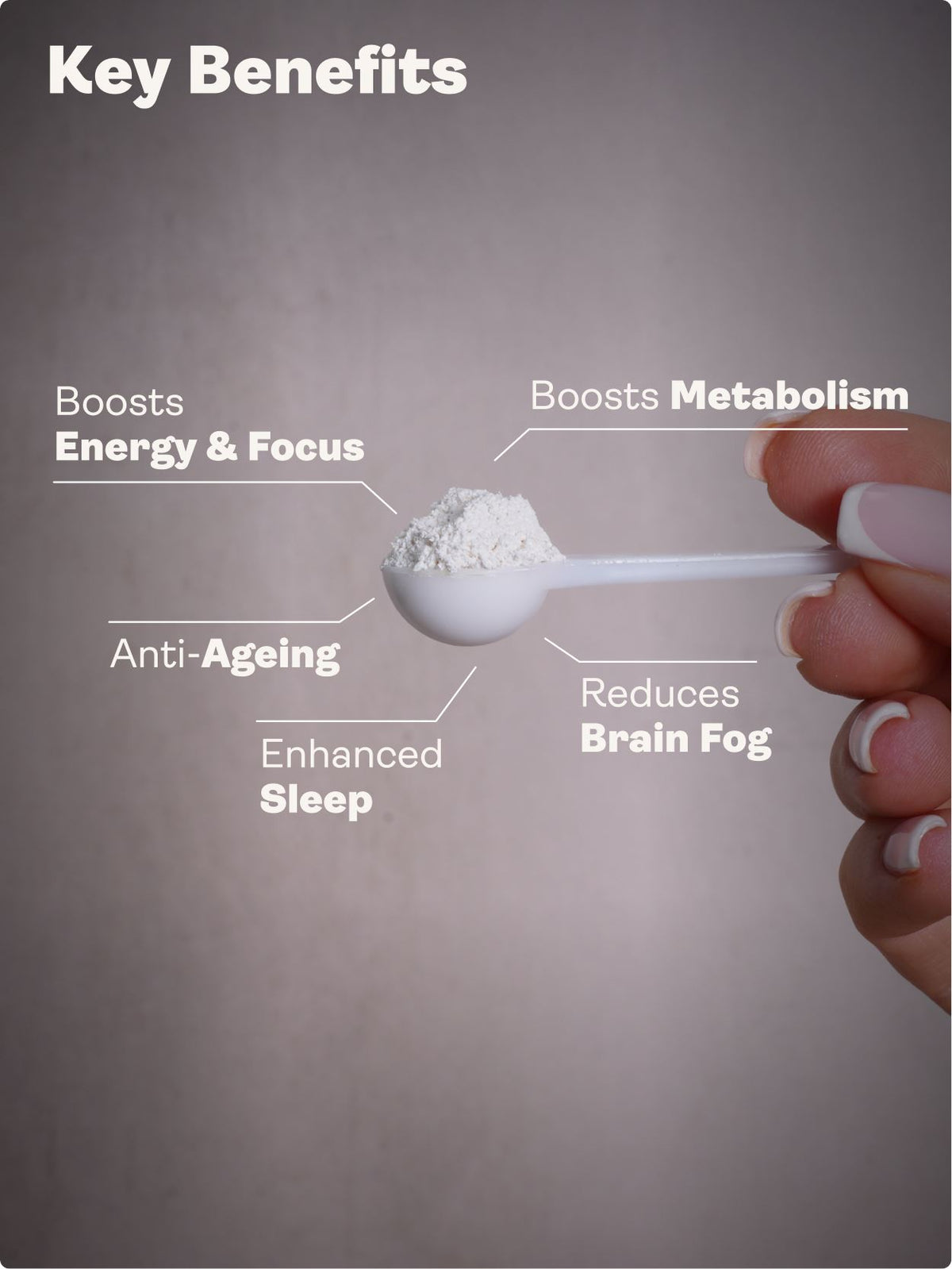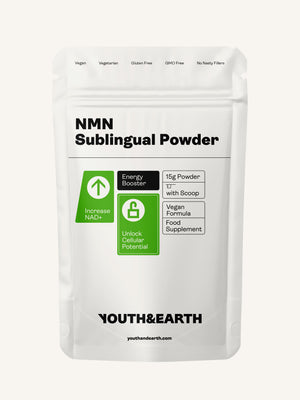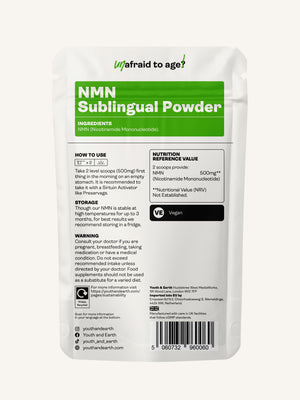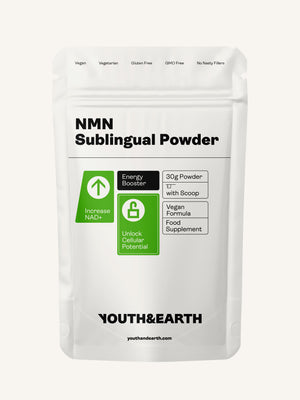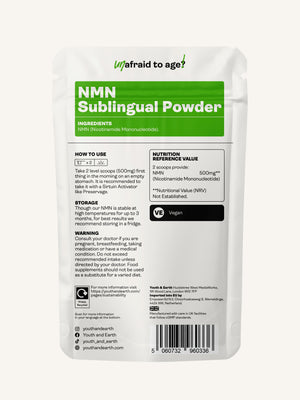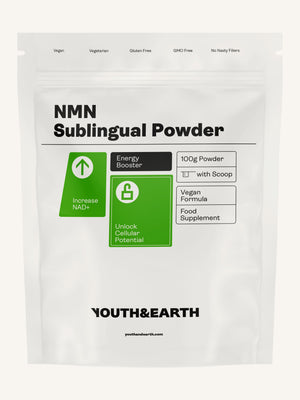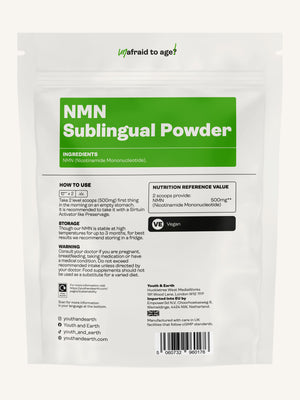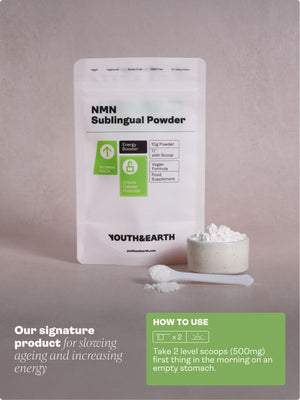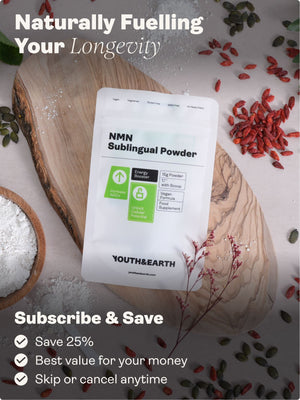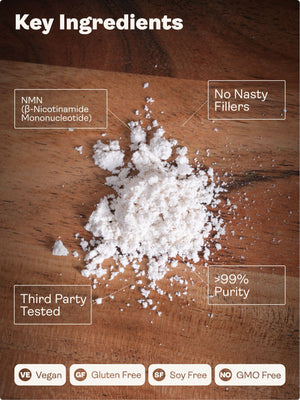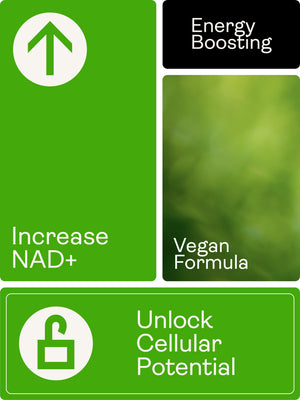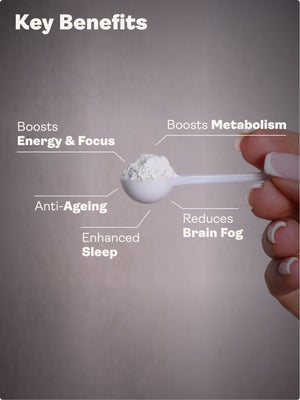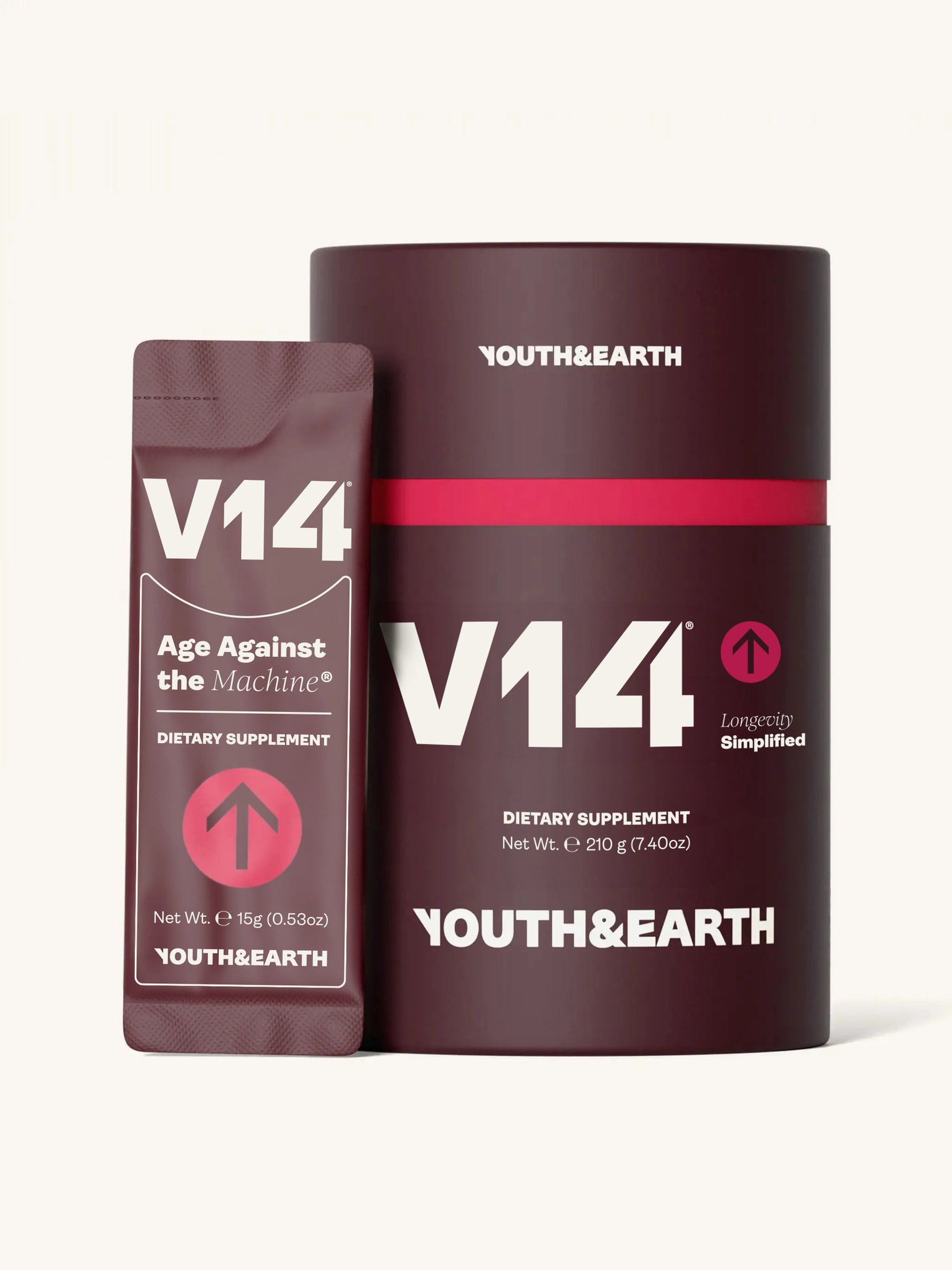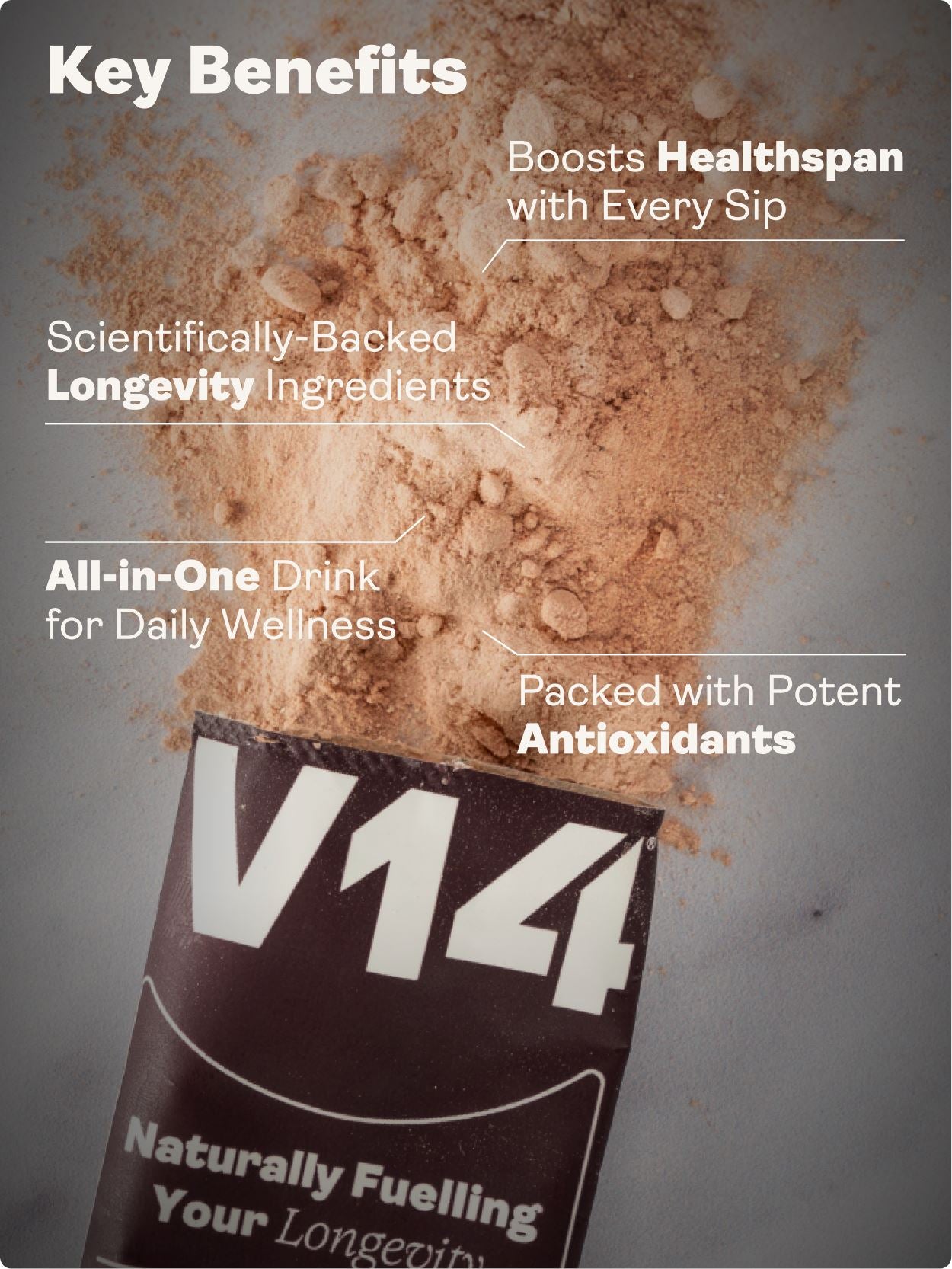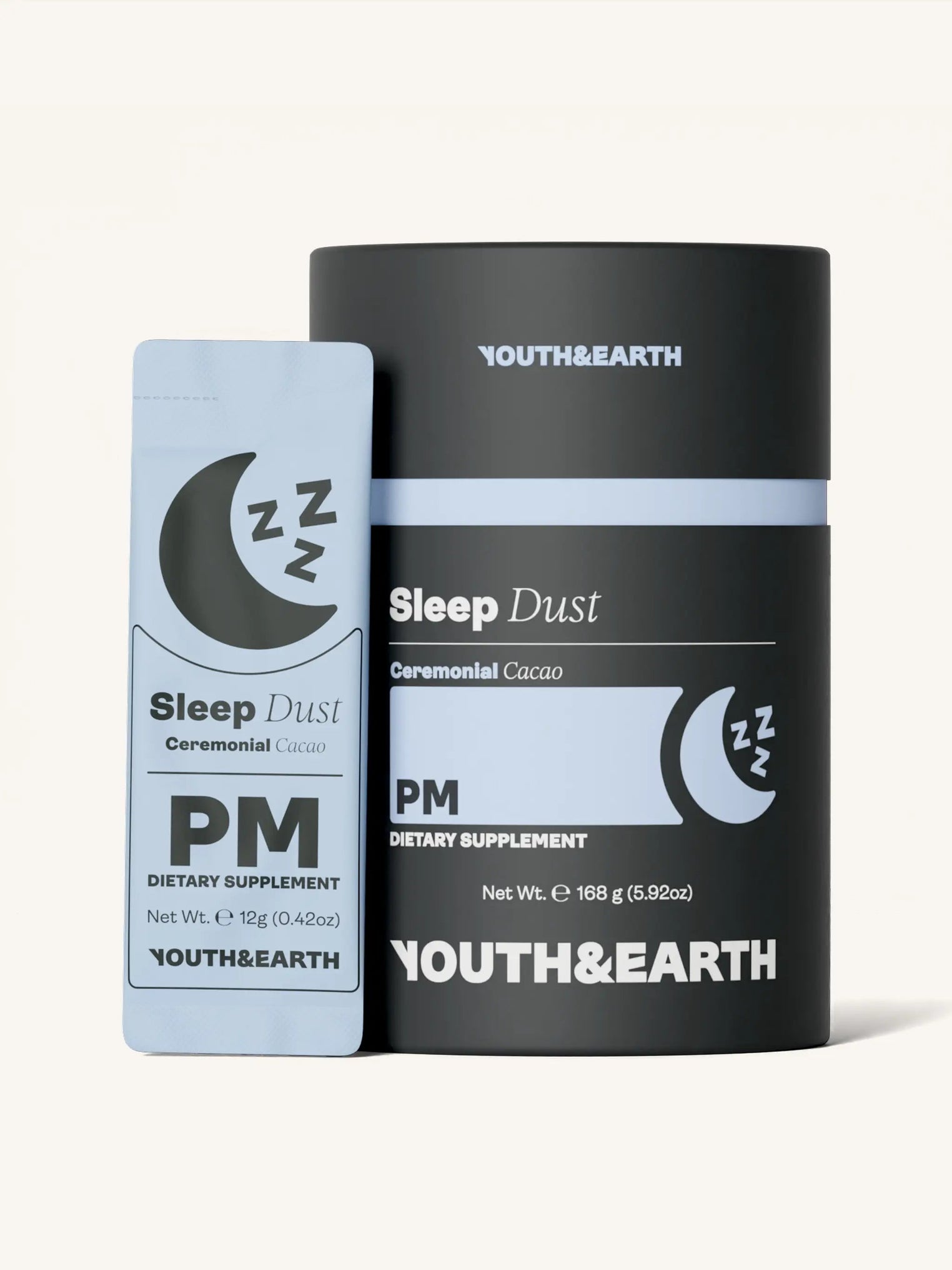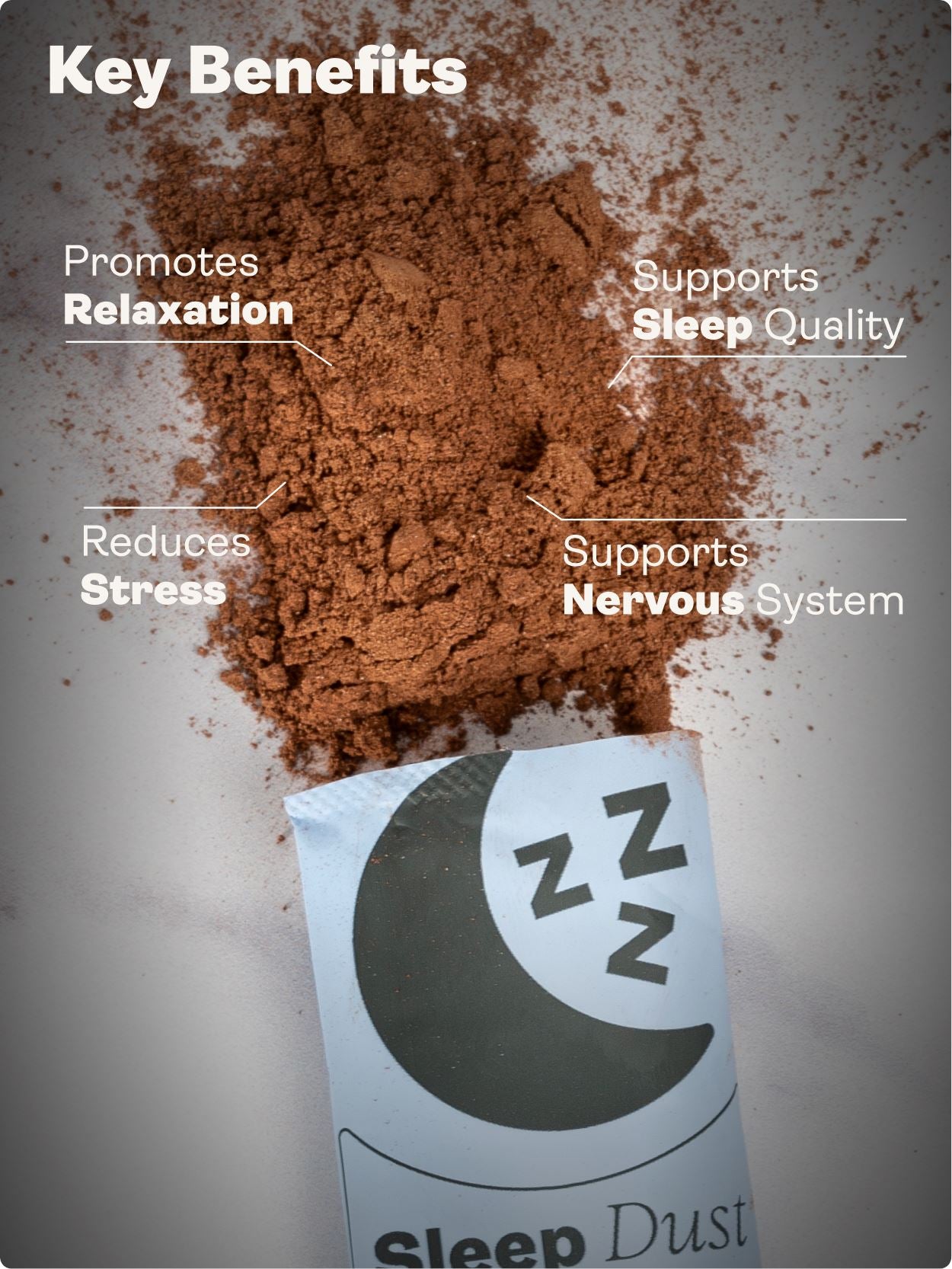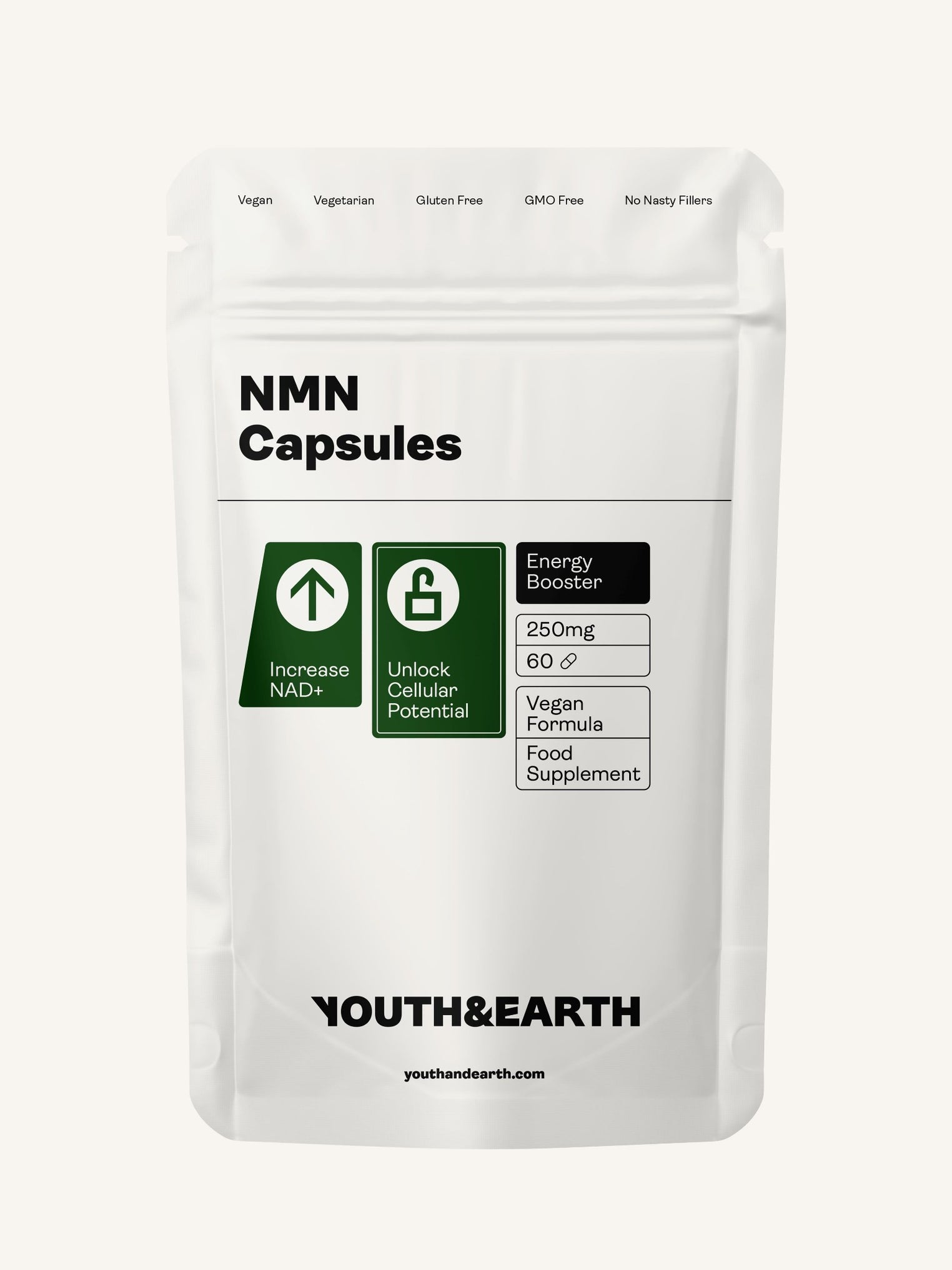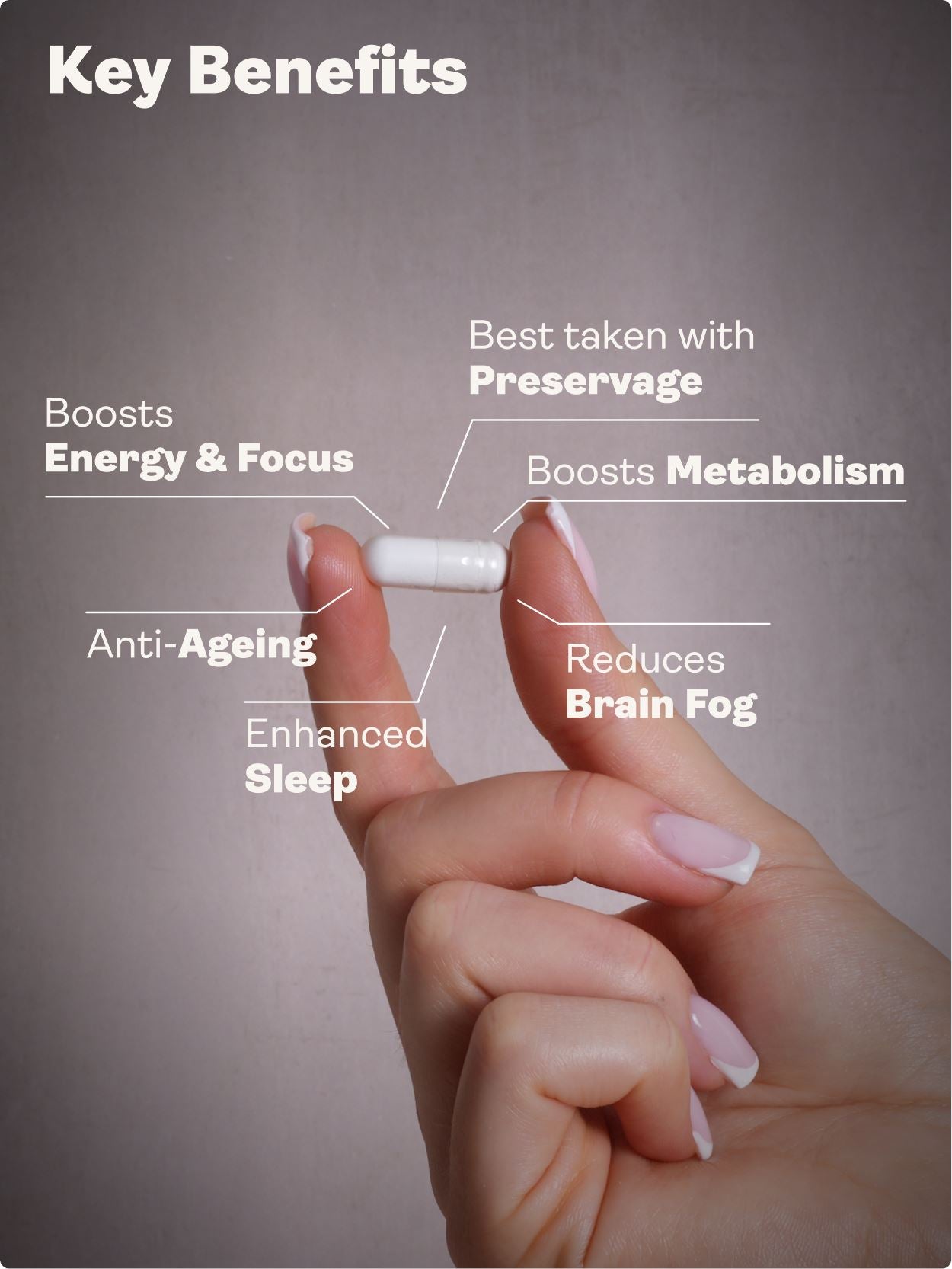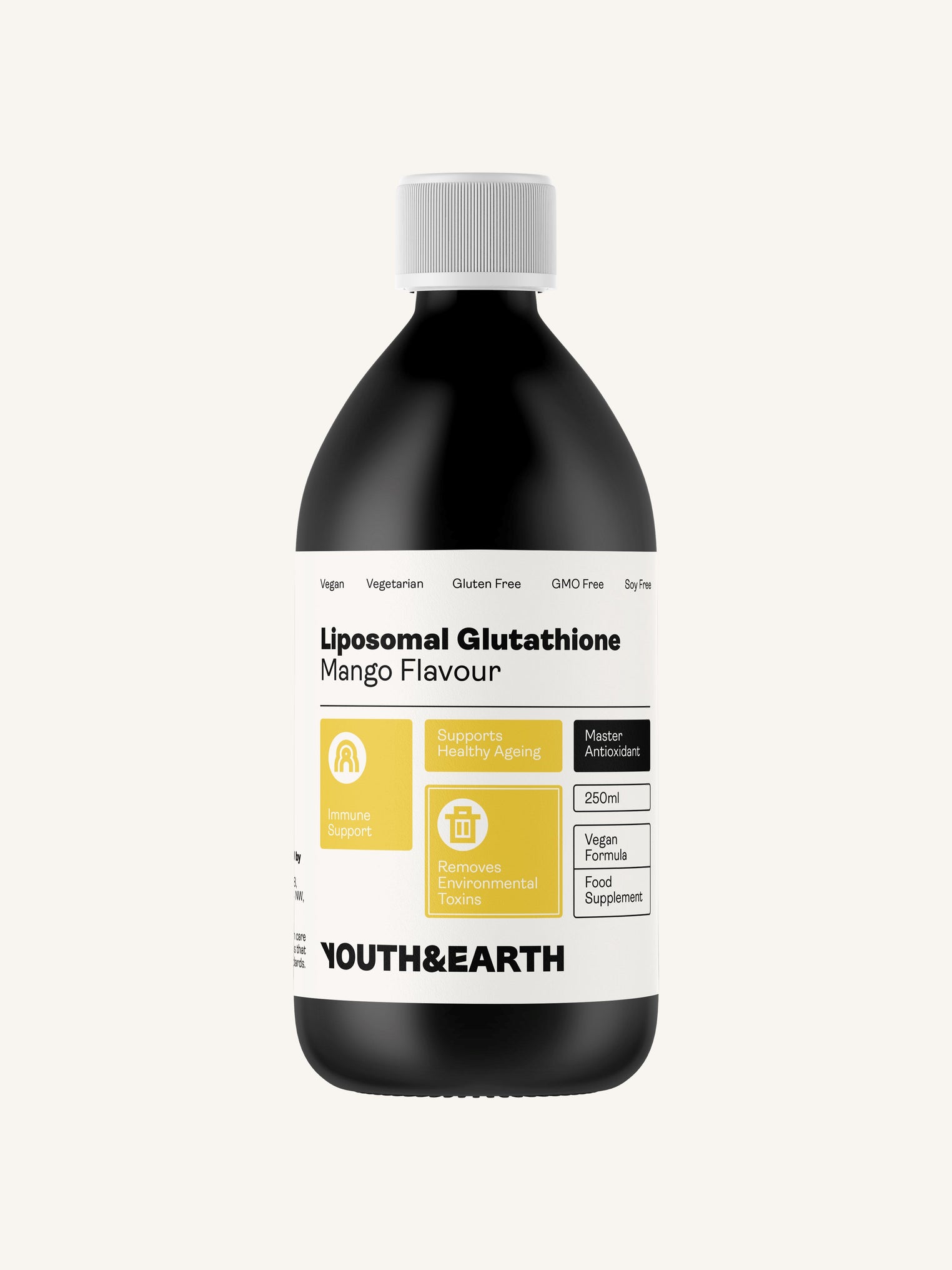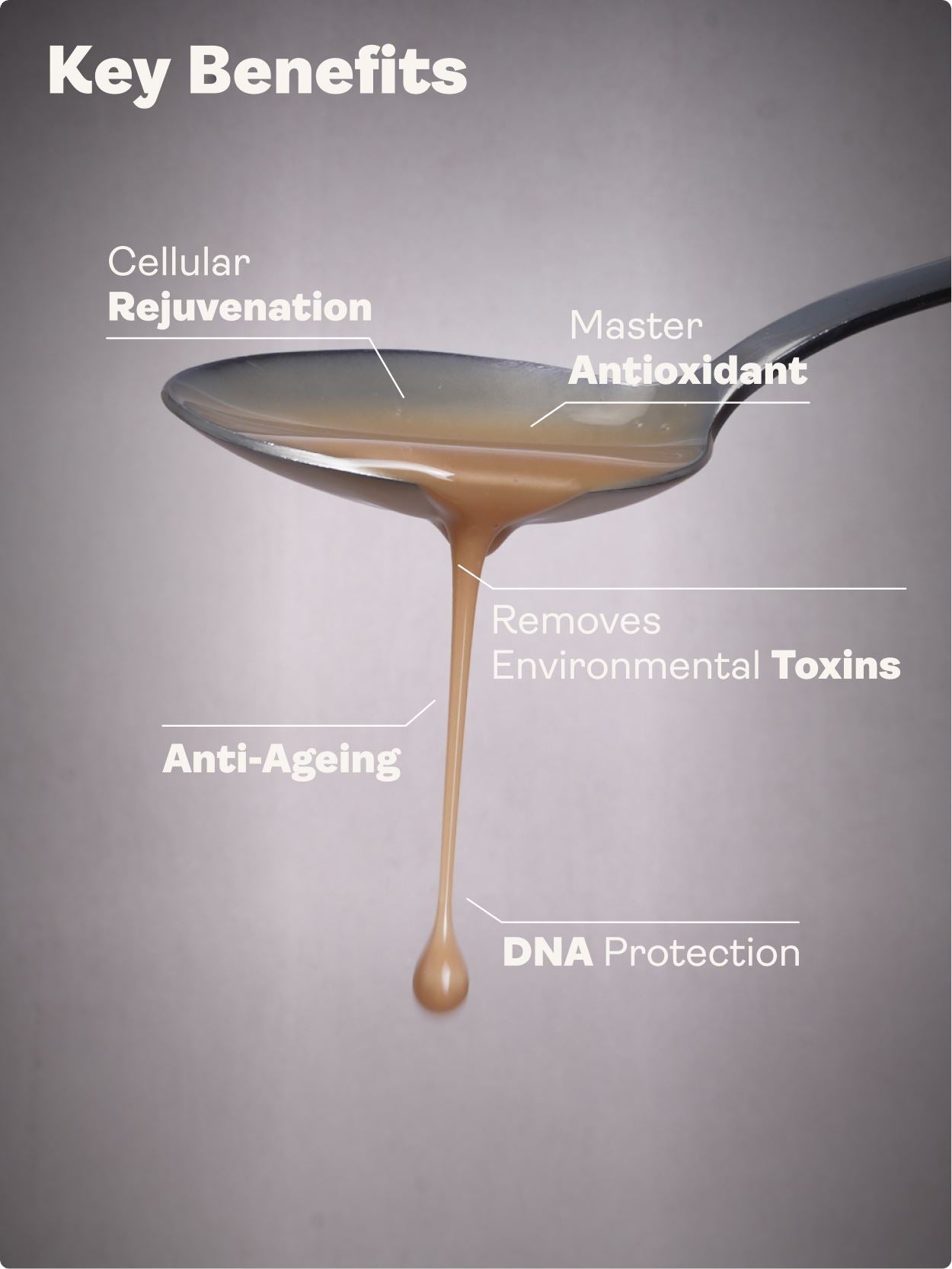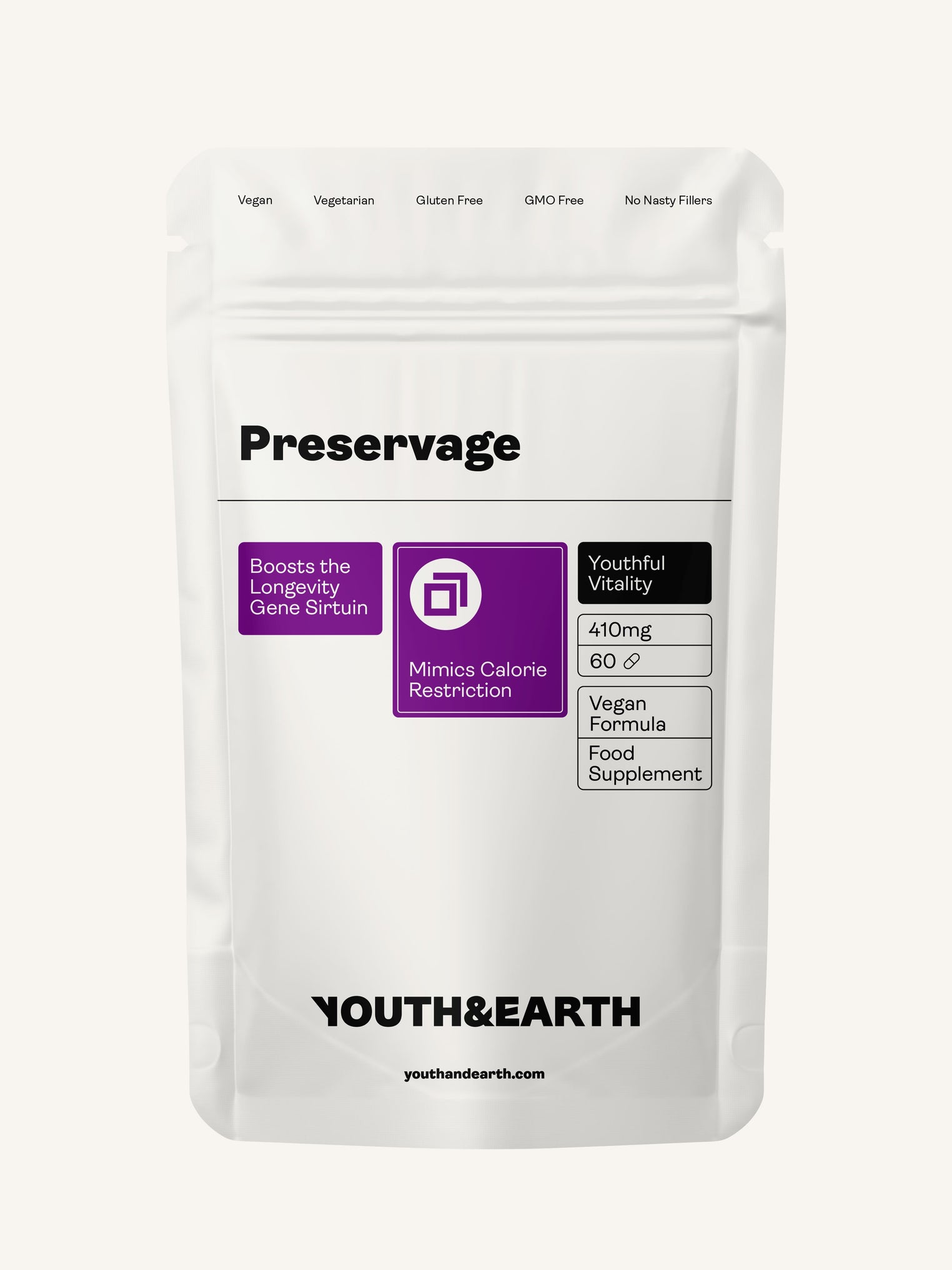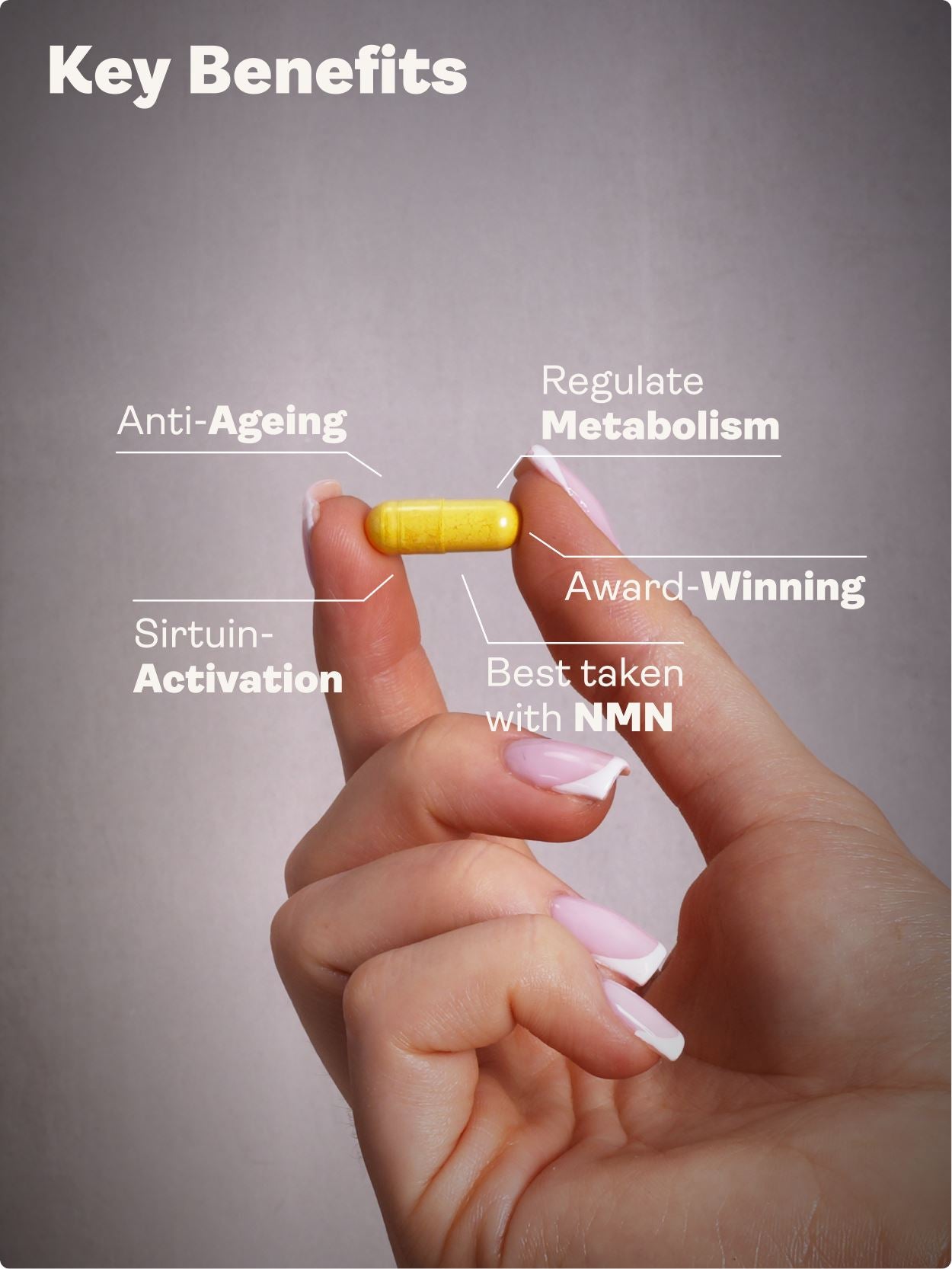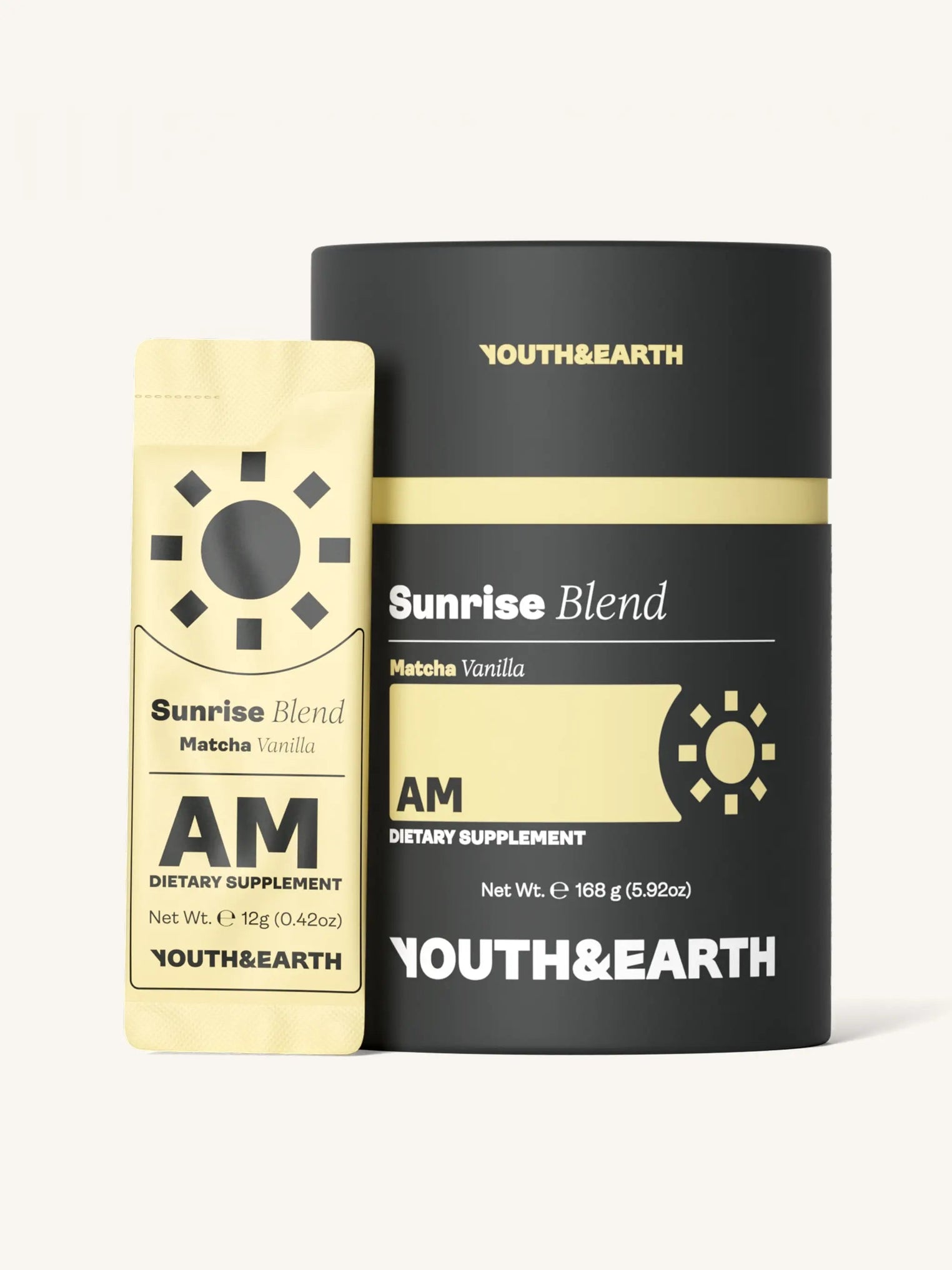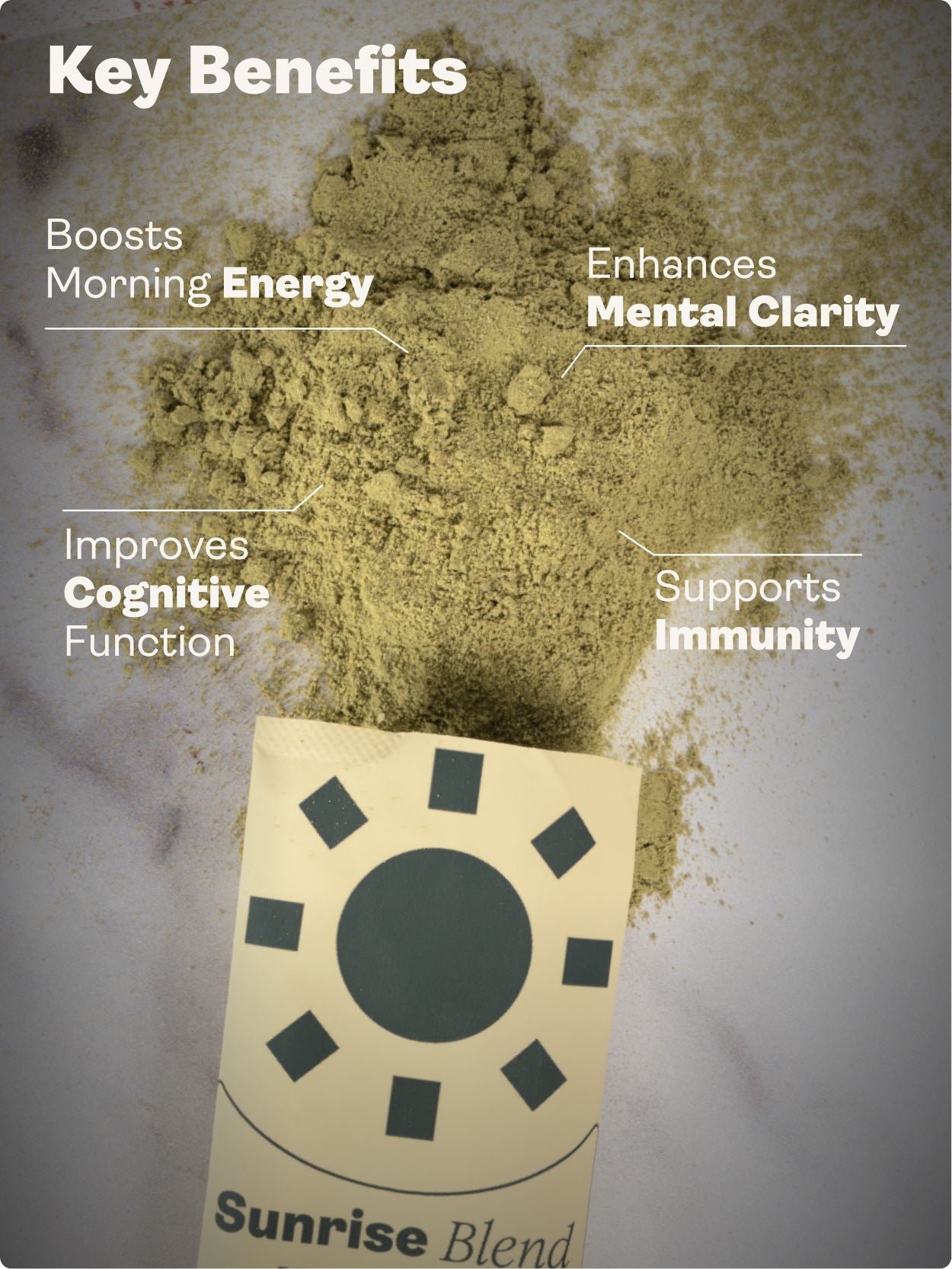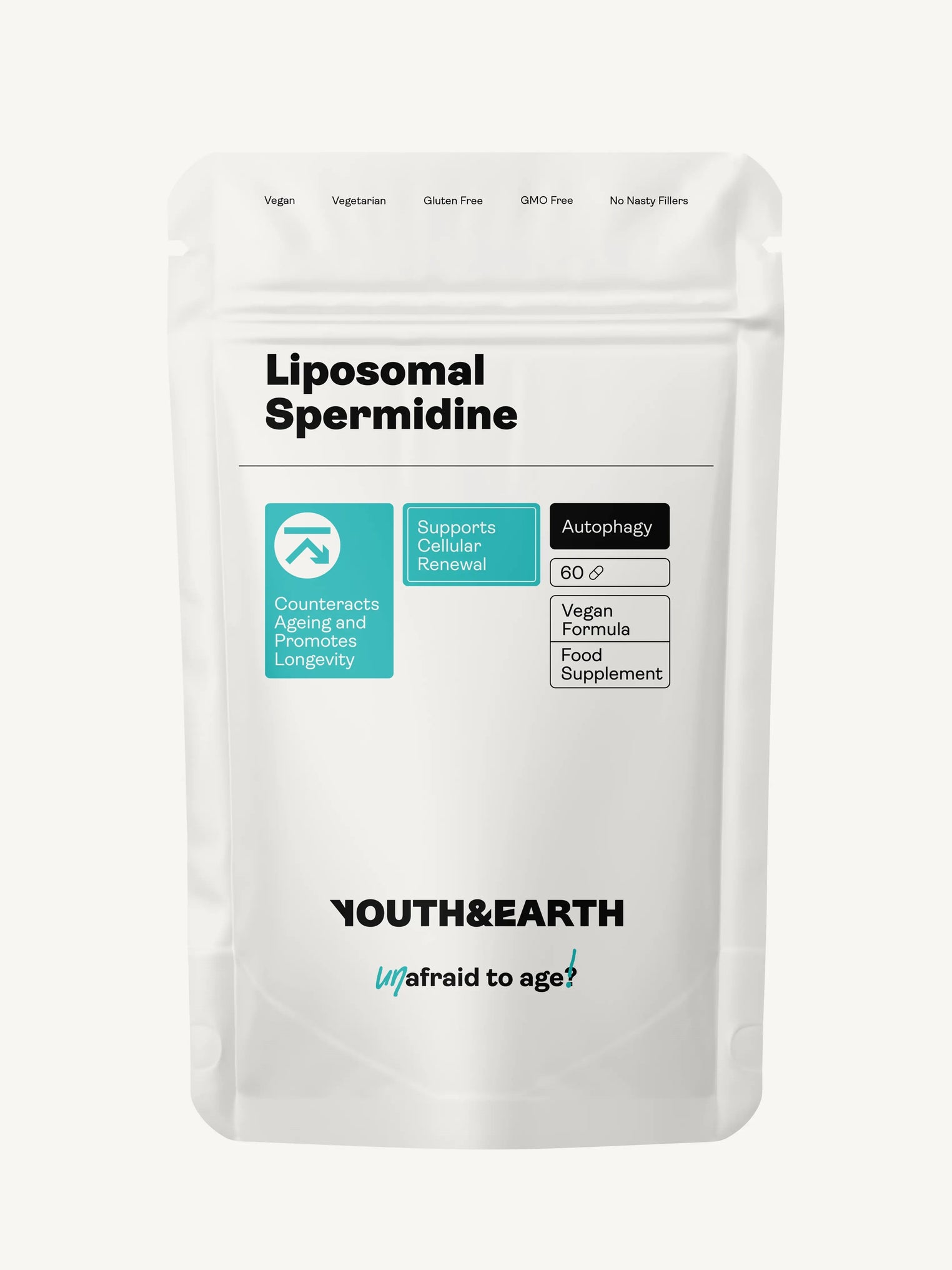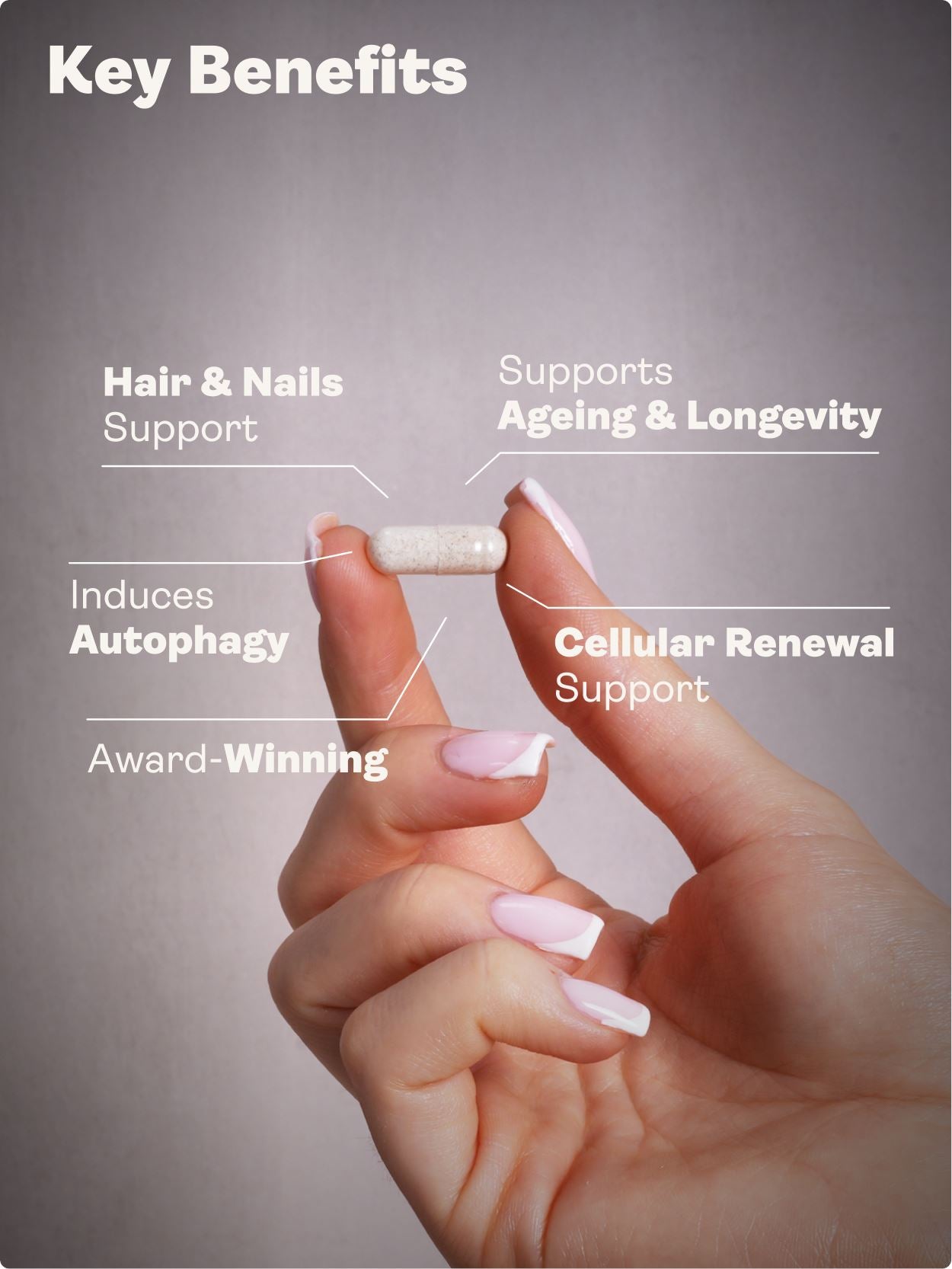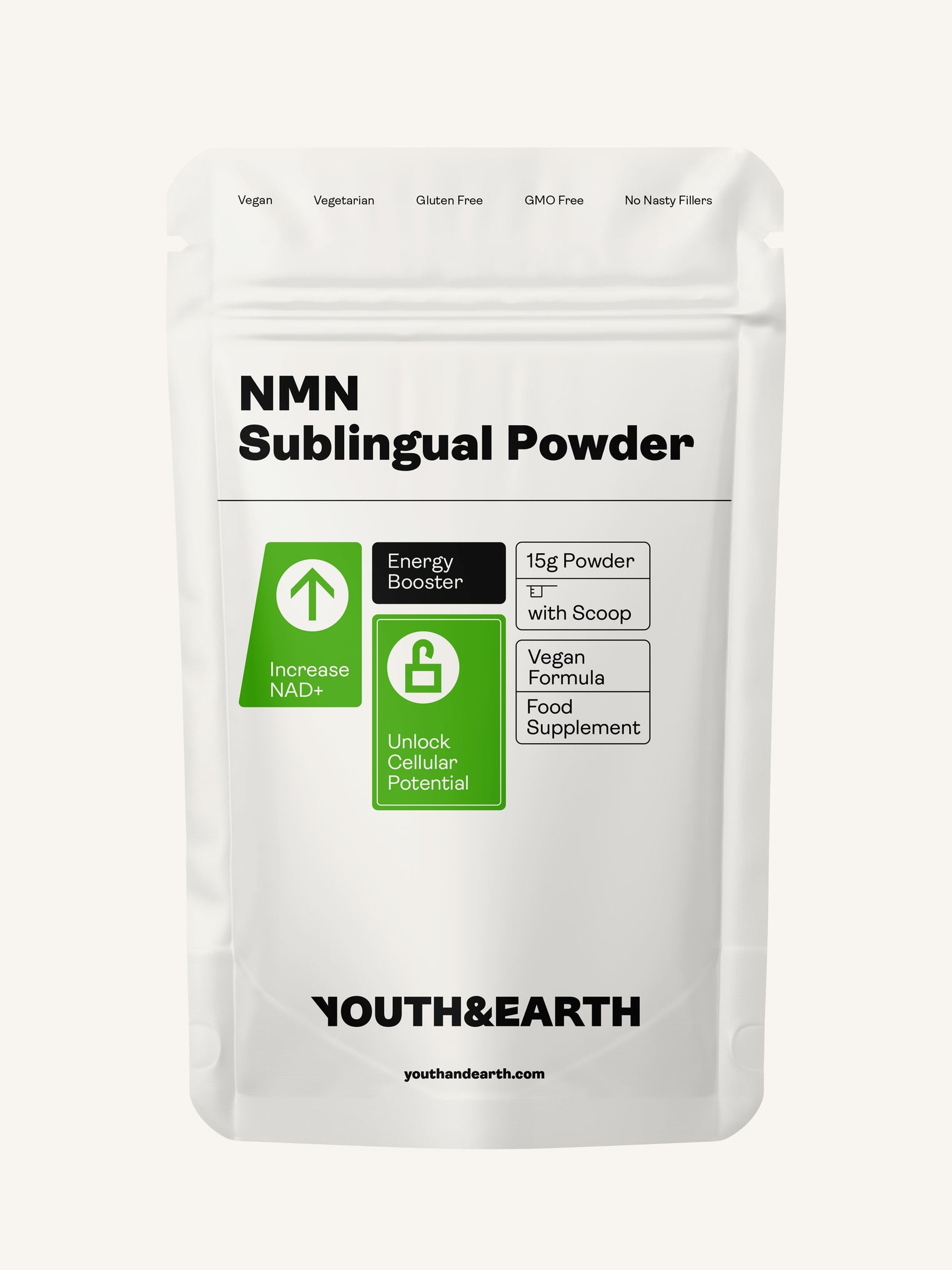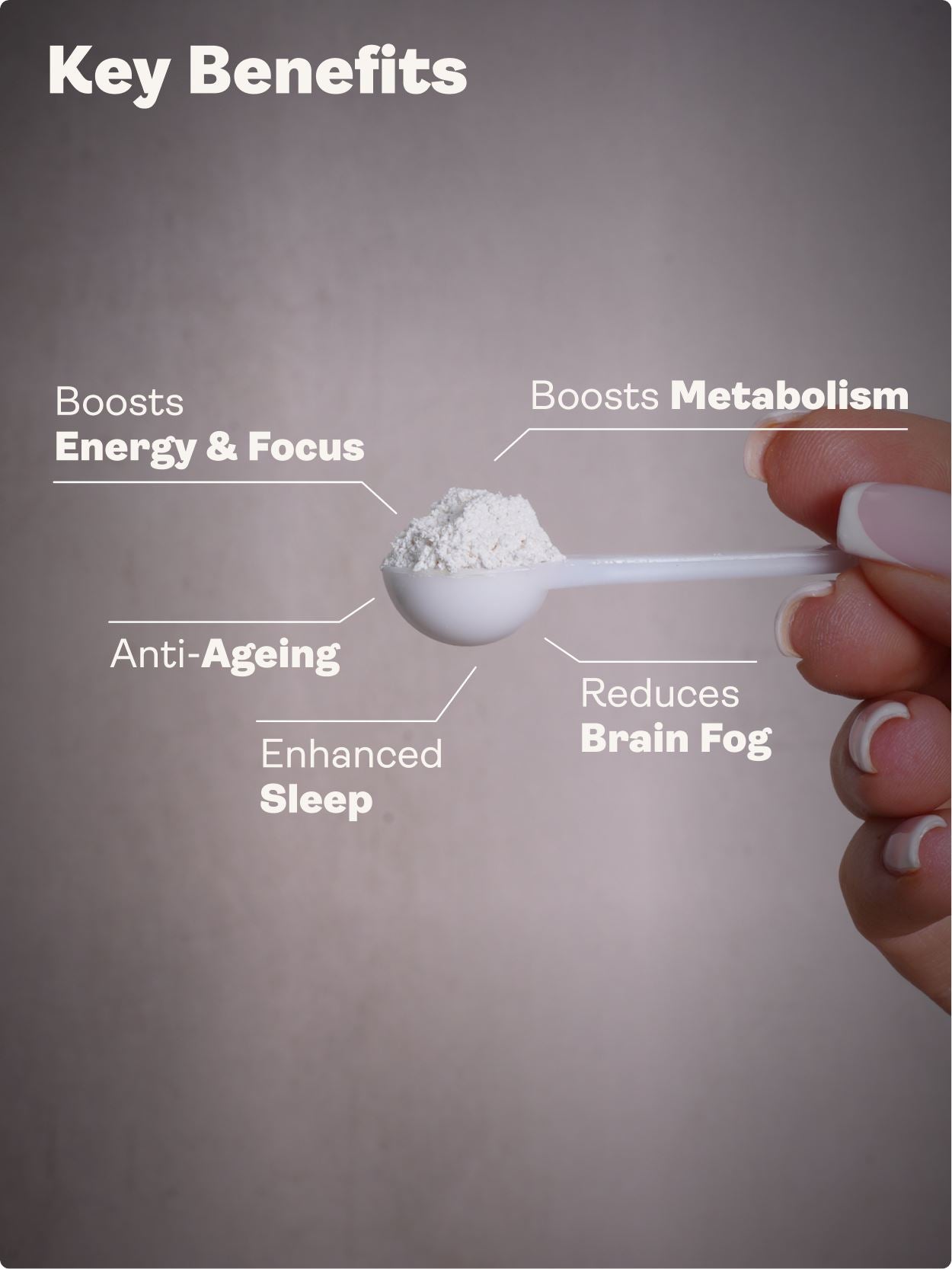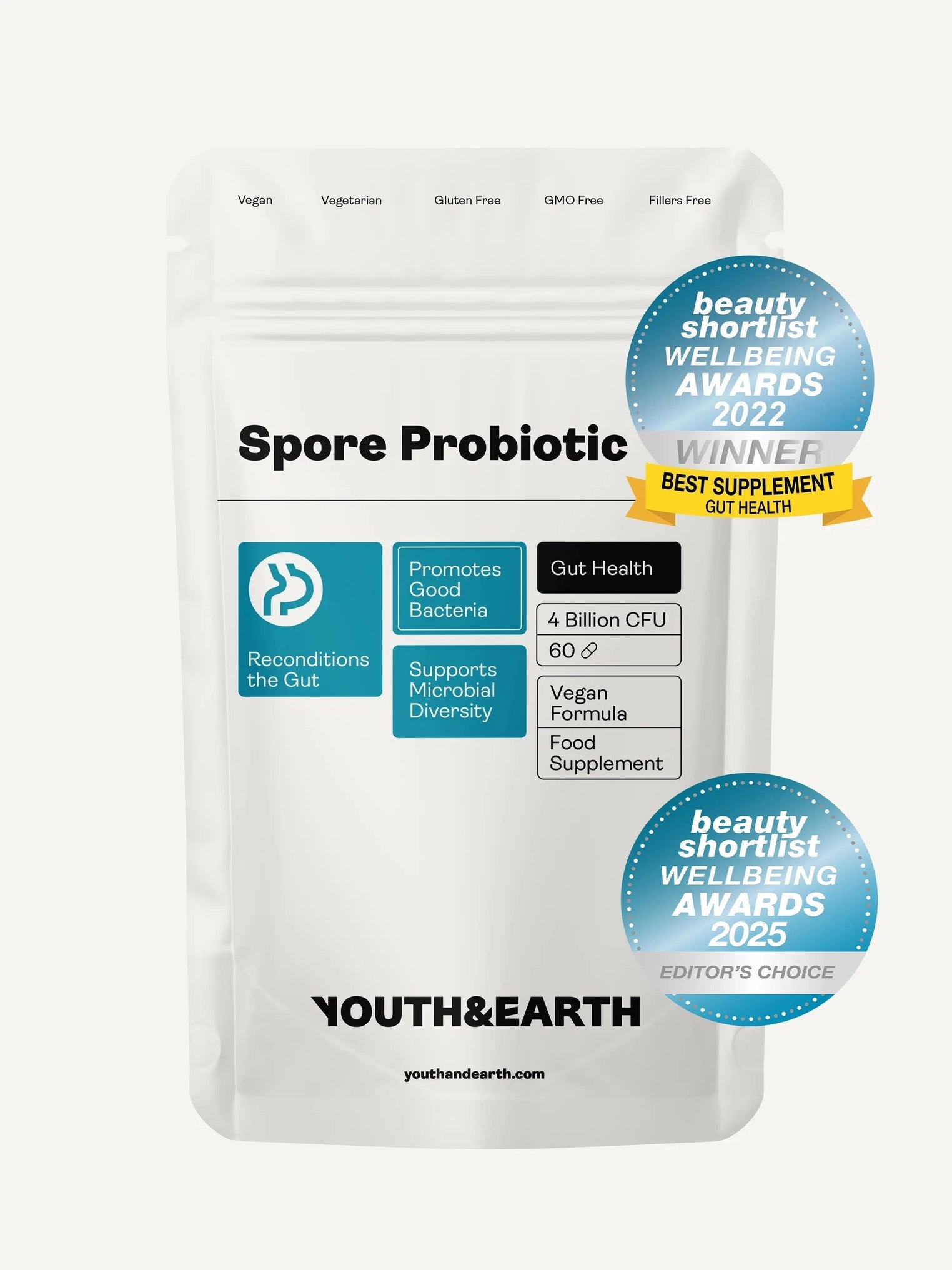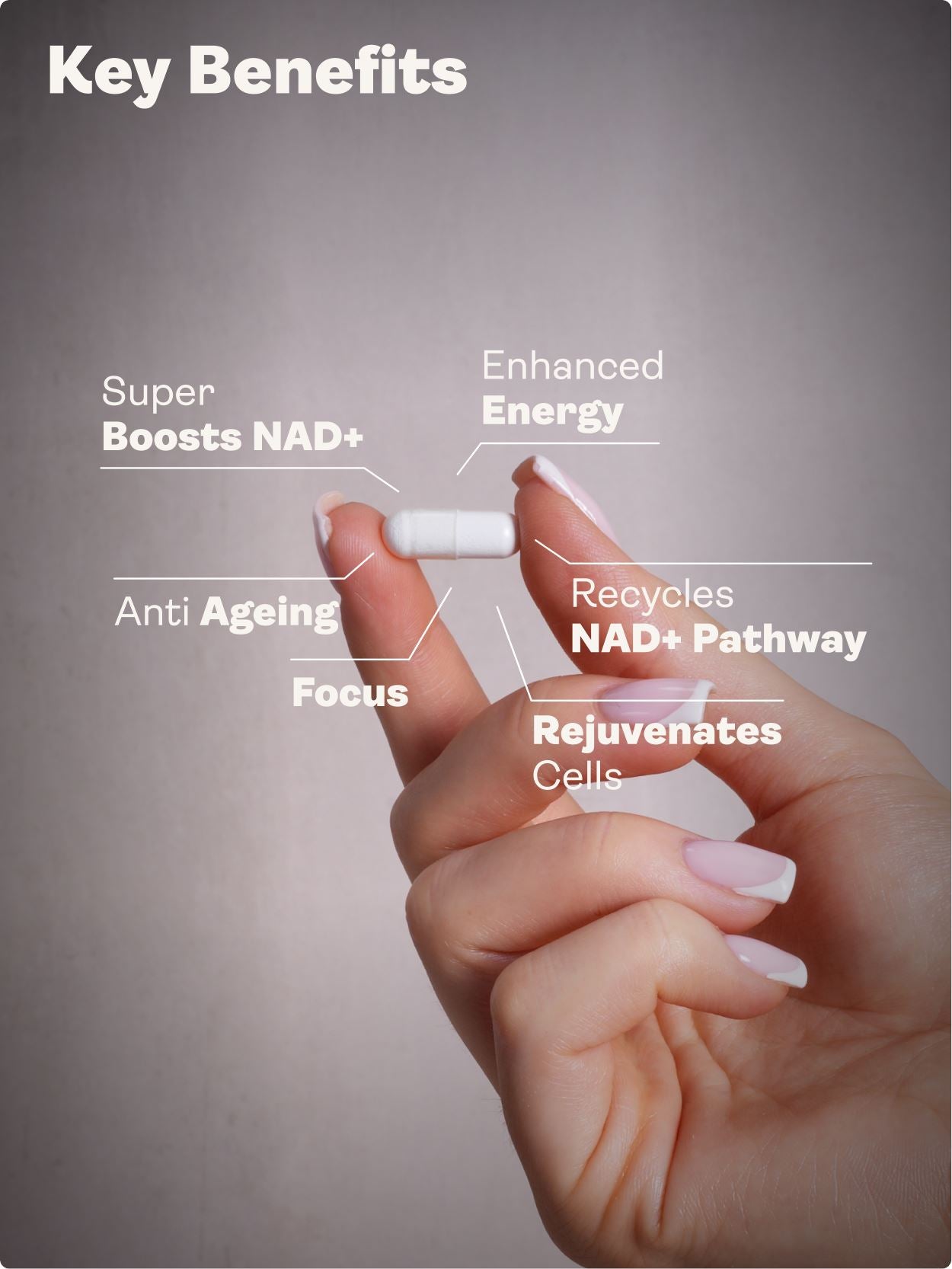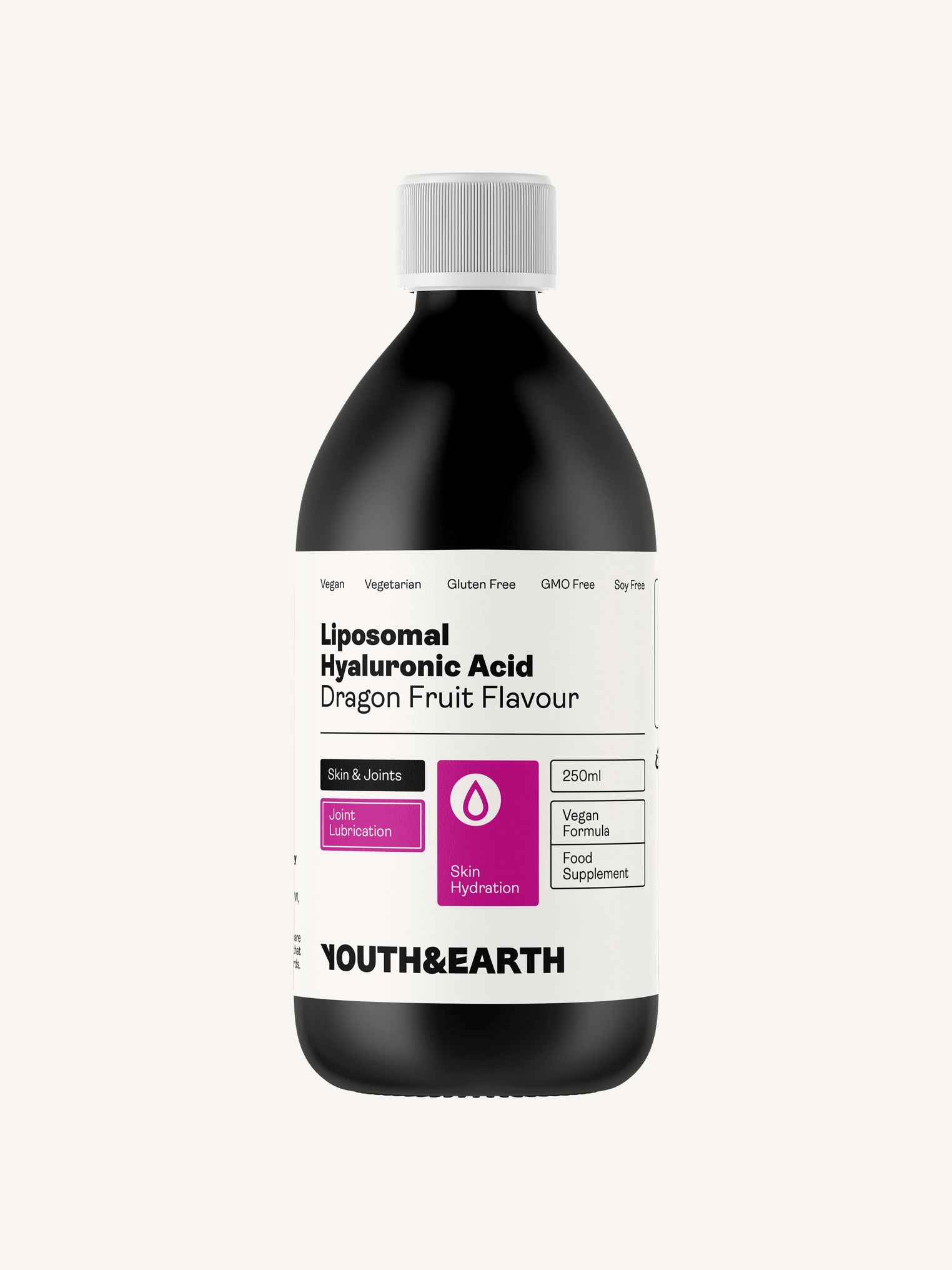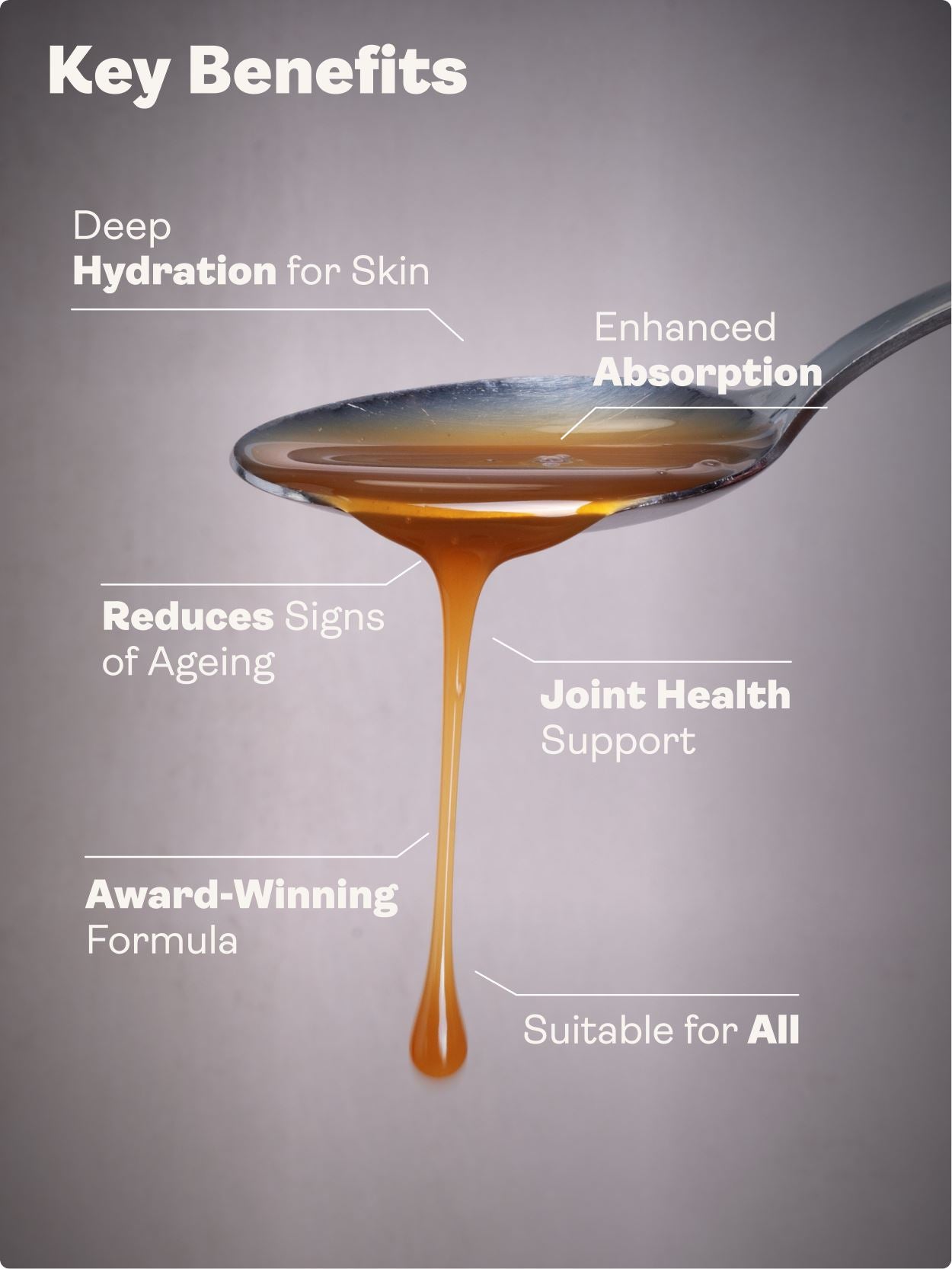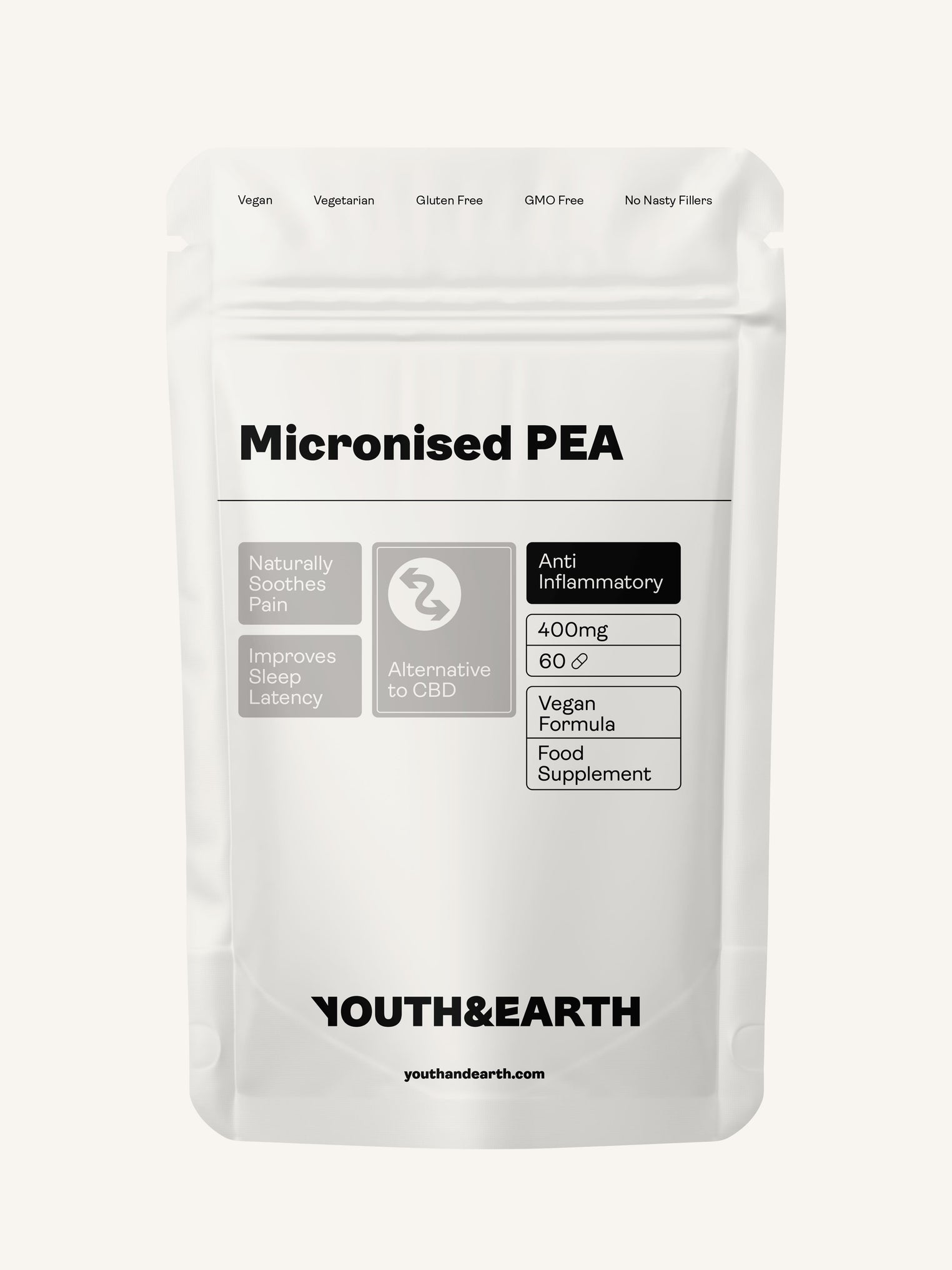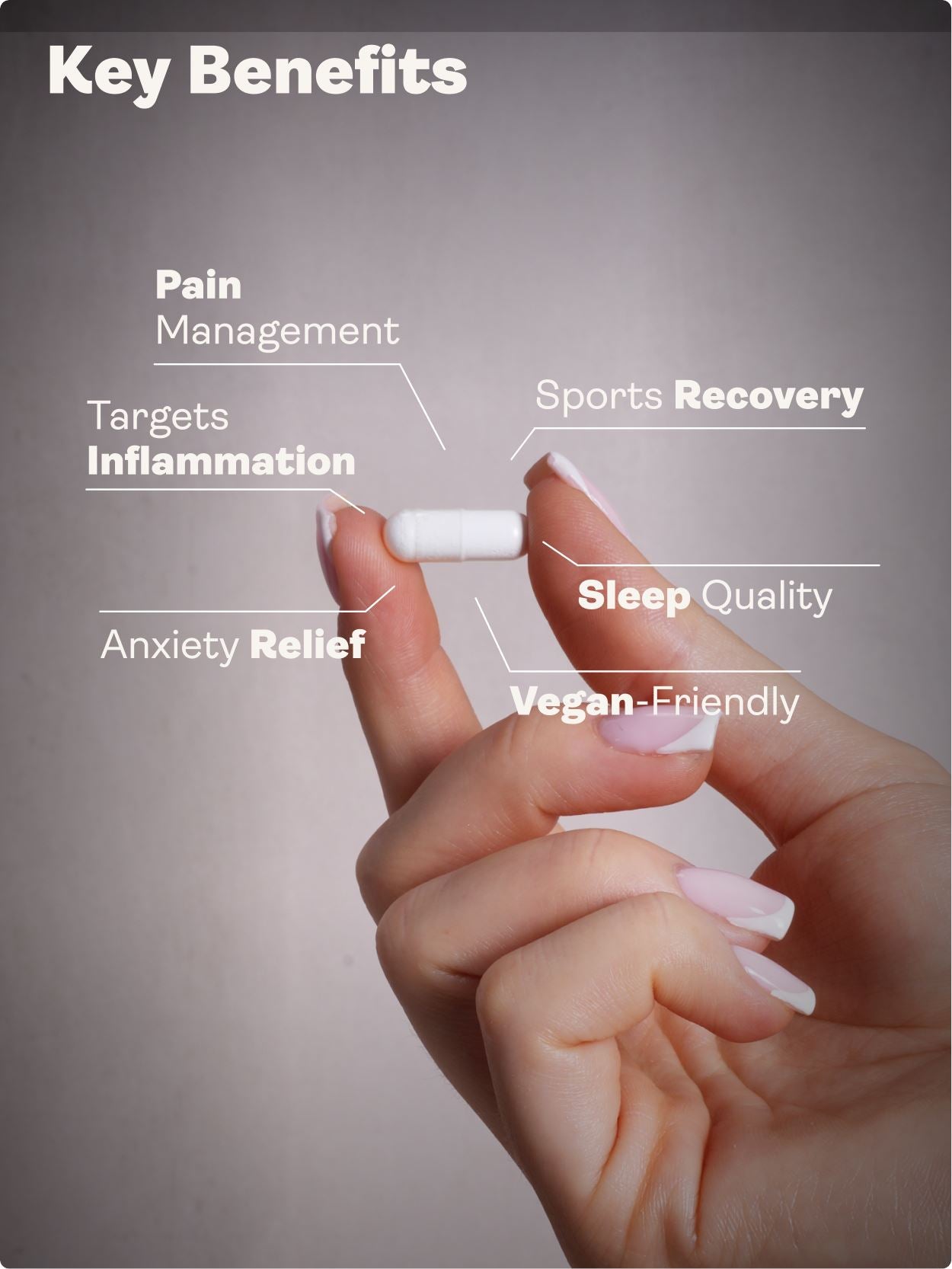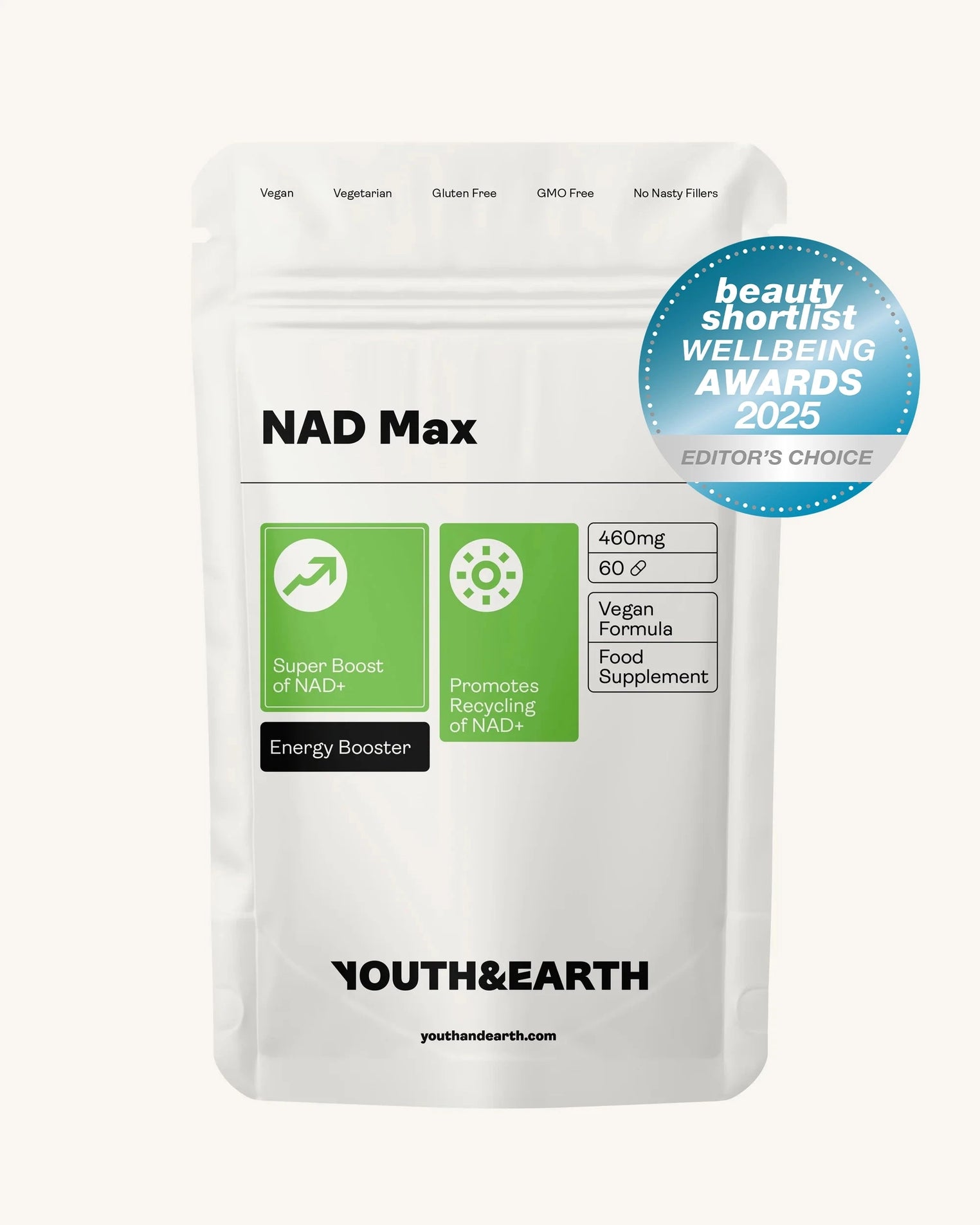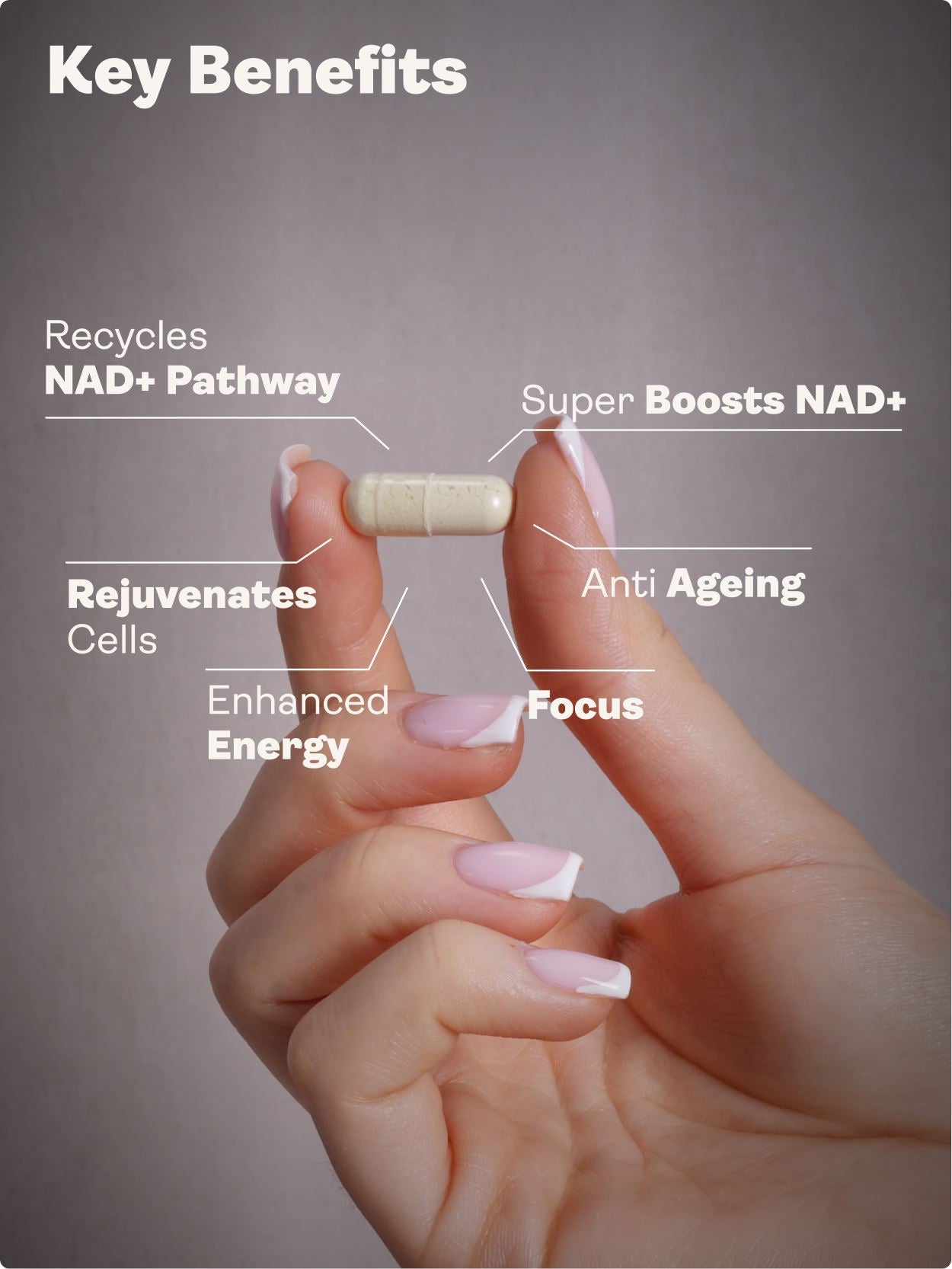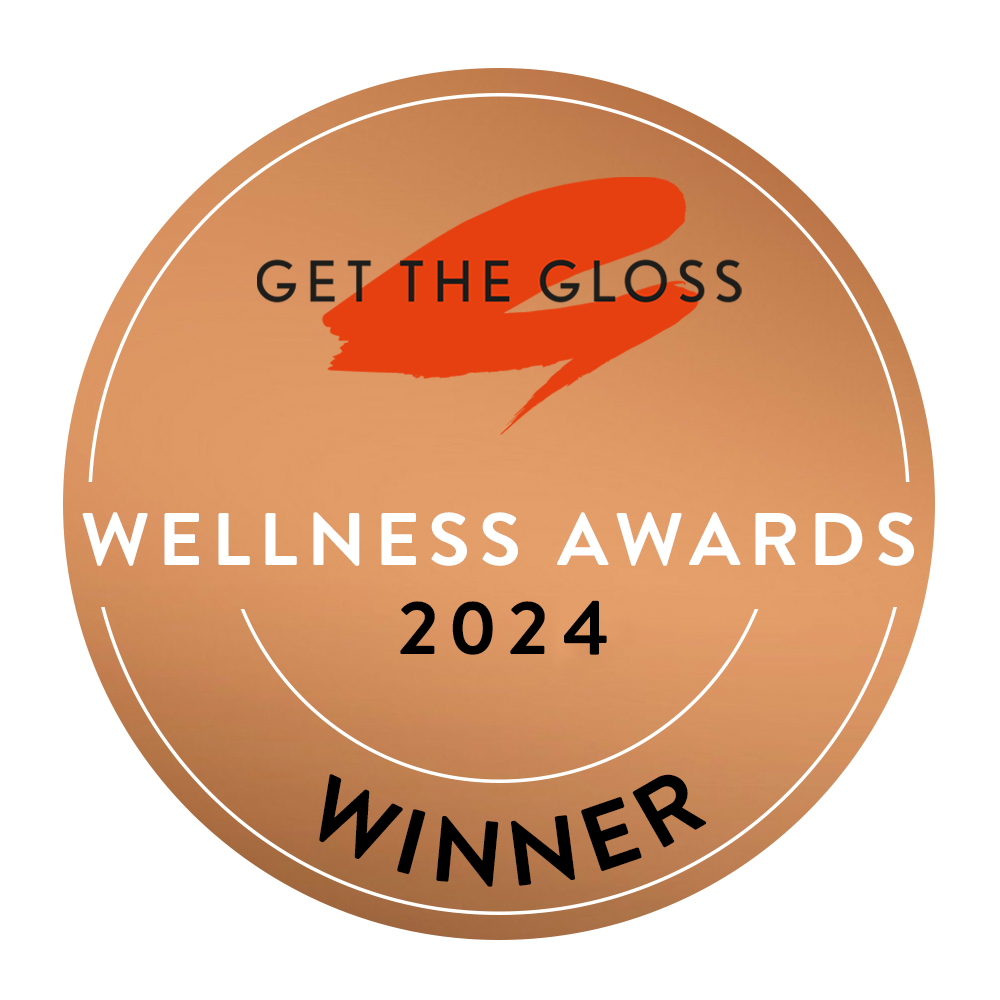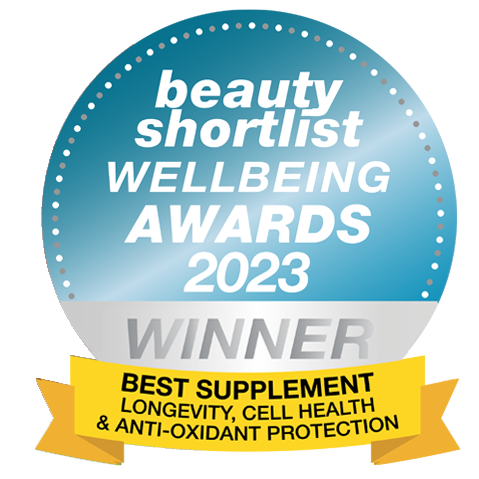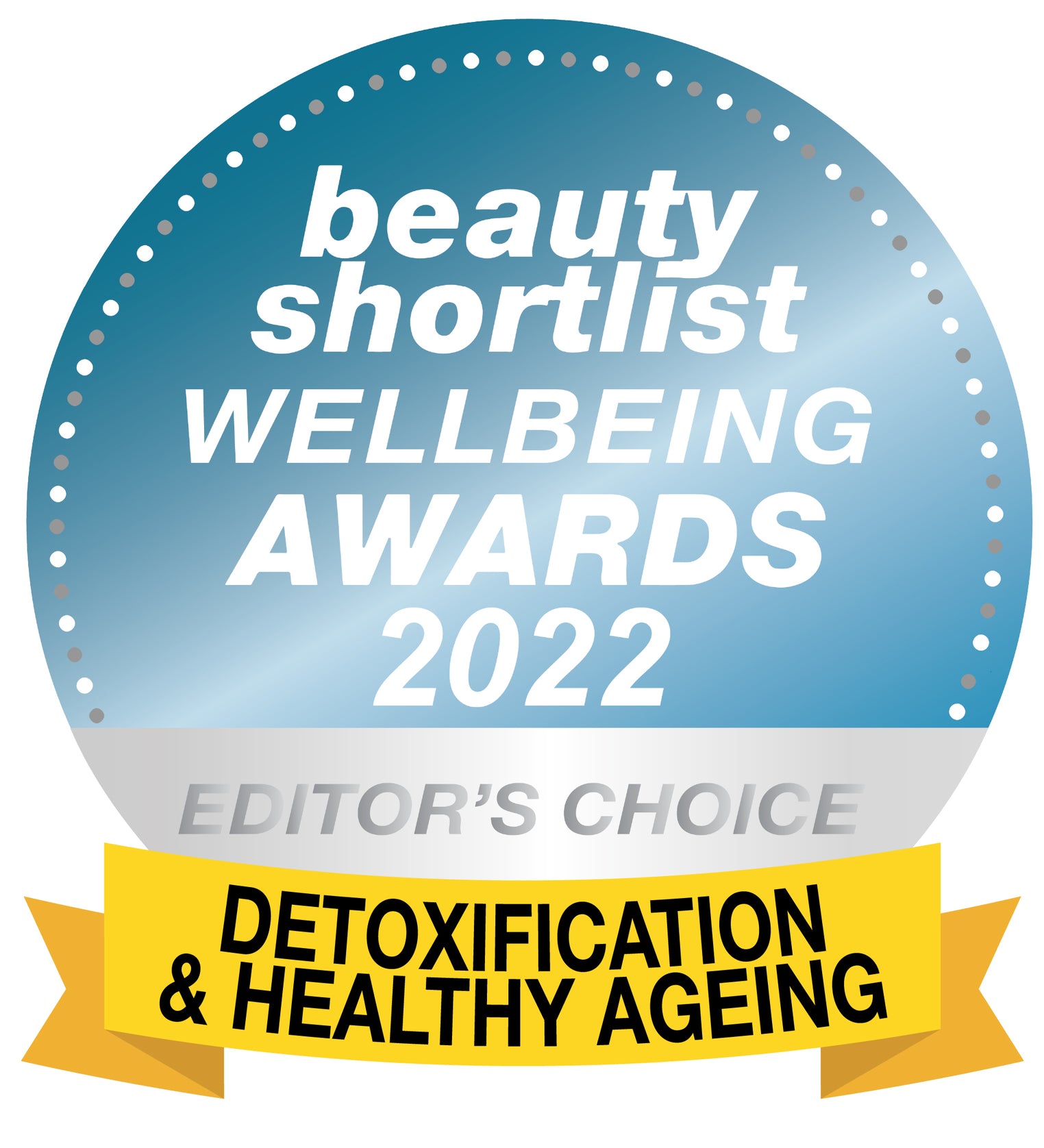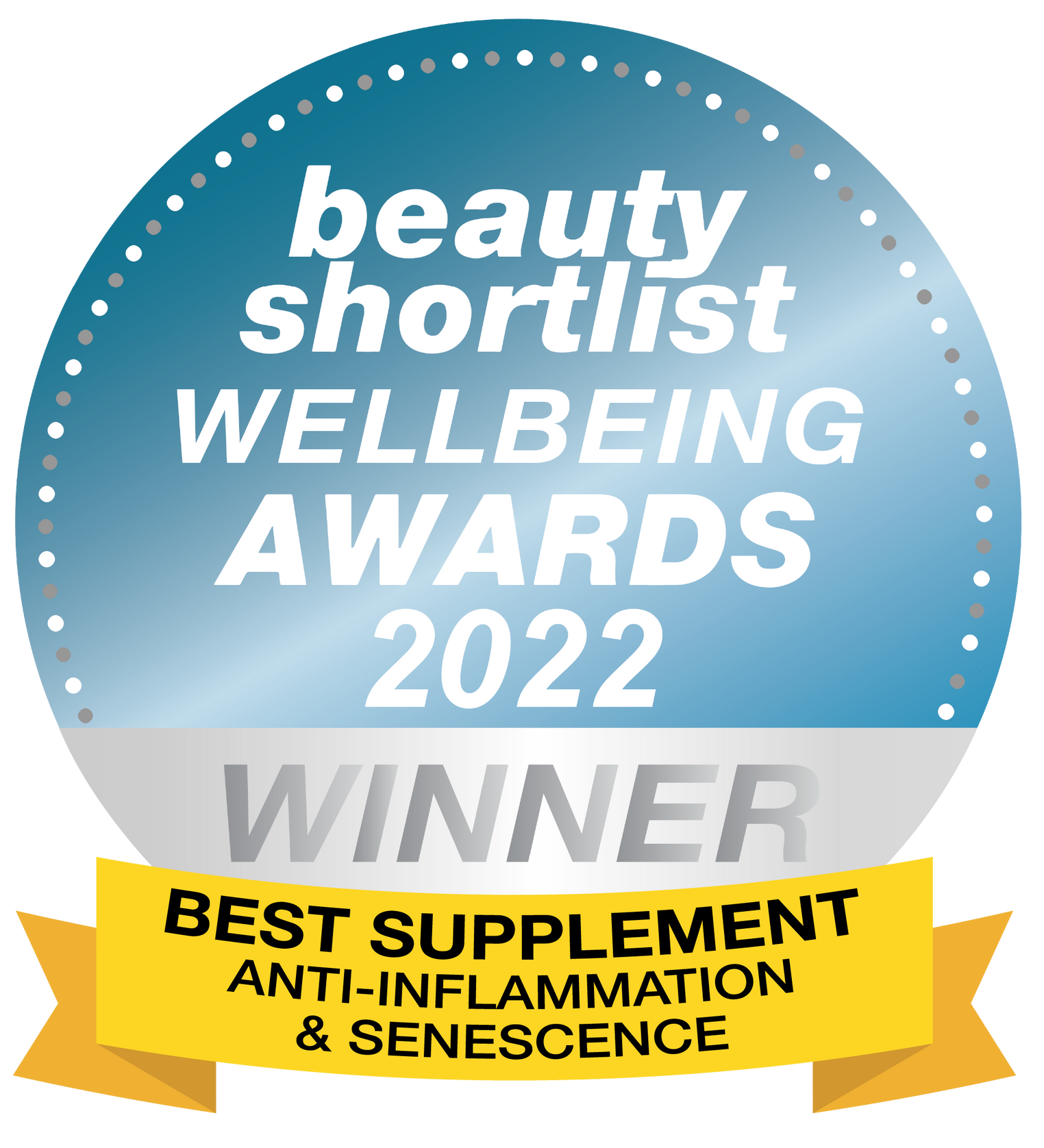Can biohacking unlock a longer, healthier life? Precursors like Nicotinamide Riboside (NR) and Nicotinamide Mononucleotide (NMN) are key to boosting NAD+ (Nicotinamide Adenine Dinucleotide), a vital coenzyme for cellular energy and anti-aging. This article explores how precursors, including those for glutathione, fuel biohacking strategies, supporting vitamin synthesis, energy production, and longevity pathways while preserving the body’s resilience.
TL;DR: Precursors for Biohacking and Longevity
Precursors are compounds transformed into active substances like vitamins, hormones, or enzymes, critical for biohacking and anti-aging. NR and NMN boost NAD+ levels, enhancing cellular energy and mitochondrial function. Glutathione precursors (cysteine, glutamic acid, glycine) support detoxification and oxidative stress reduction. Other precursors, like beta-carotene (vitamin A) and tyrosine (CoQ10), promote health and longevity. Combine dietary sources with supplements like liposomal CoQ10 for optimal anti-aging results.
Table of Contents
-
What Are Precursors?
-
Why Take Precursors for Glutathione?
-
Glutathione Precursors and Supplements: Why Take Them?
-
Science Snapshot: Precursors in Biohacking
-
Why Are Precursors Key for Longevity?
-
Vitamins and Their Precursors
-
How Do NAD+ Precursors Support Anti-Aging?
-
Other Anti-Aging Precursors: Tyrosine and CoQ10
-
Energy Precursors for ATP Production
-
Conclusion: Biohacking Longevity with Precursors
-
Frequently Asked Questions (FAQ)
-
Glossary of Terms
-
About the Author & Last Updated
What are Precursors?
Precursors are inactive chemicals that can be transformed into other active compounds such as vitamins, hormones, or enzymes. They are the substance that needs to “run before” another one can be produced in a chemical reaction.
Another way to view precursors is a bit like the ingredients to a cake. Usually, to make a cake you need some form of wet and dry ingredients. If you don’t have dry ingredients, like flour, no matter what you try, you won’t have a cake.
A good example of this is in our bodies is cholesterol. Despite the general misconception that cholesterol is “bad,” your body needs this substance to make testosterone — cholesterol is the building block for testosterone.
In men, testosterone is made from cholesterol in the testicular Leydig cell and is an essential precursor to all steroid hormones.
Perhaps more well-known precursors are the ones used to make vitamins. We all know carrots contain vitamin A, but that’s not quite right. Carrots contain beta-carotene which is a precursor or building block to vitamin A.
Why Take Precursors for Glutathione?
Glutathione, a powerful antioxidant, protects cells from oxidative stress, supports detoxification, and promotes longevity, making it a cornerstone of biohacking. Taking precursors like cysteine, glutamic acid, and glycine ensures the body can synthesize sufficient glutathione, as direct supplementation is less effective due to poor absorption unless you take a Liposomal form which you can find here.
-
Why It Matters: Glutathione levels decline with age, increasing oxidative damage and age-related diseases. Precursors like N-acetylcysteine (NAC) provide cysteine, the rate-limiting component, boosting glutathione production. Studies show NAC (600–1800 mg/day) can increase glutathione levels by up to 30% in older adults.
-
How It Works: Cysteine, glutamic acid, and glycine combine in two enzymatic steps to form glutathione, which neutralizes reactive oxygen species (ROS) and supports liver detoxification.
-
Biohacking Benefits: Precursors enhance cellular repair, reduce inflammation, and support mitochondrial health, key anti-aging mechanisms. Combining precursors with practices like intermittent fasting amplifies detoxification and longevity.
-
Sources and Supplements: Eggs, broccoli, and bone broth provide precursors, while NAC, L-glutamine, and L-glycine supplements ensure optimal synthesis.
Biohacking Tip: Pair GLYNAC (1000 mg/day) with a sulfur-rich diet (e.g., garlic, onions) to maximize glutathione production and support anti-aging pathways.
Glutathione Precursors and Supplements: Why Take Them?
Glutathione synthesis relies on specific precursors and co-factors, each available as supplements to optimize antioxidant levels and longevity. Below is a comparison of key glutathione precursors and supplements, their purposes, benefits, and biohacking tips.
|
Supplement |
Purpose |
Why It Matters |
How It Works |
Biohacking Tip |
|---|---|---|---|---|
|
N-Acetylcysteine (NAC) |
Provides cysteine, the rate-limiting precursor for glutathione synthesis |
Increases glutathione levels by up to 30% (600–1800 mg/day), supporting detoxification and cellular repair |
Delivers stable cysteine, enhancing glutathione production and protecting against ROS-induced damage |
Combine with intermittent fasting to amplify detoxification and reduce inflammation |
|
Whey Protein |
Contains glutamylcysteine, a direct glutathione precursor |
Increases lymphocyte glutathione by 24% (15–45 g/day), supporting immune health and longevity |
Provides cysteine in a bioavailable form, promoting glutathione synthesis and muscle recovery |
Choose grass-fed, undenatured whey and pair with resistance training |
|
L-Cysteine |
Directly supplies cysteine for glutathione production |
Supports antioxidant defenses, particularly in high oxidative stress |
Directly contributes to glutathione synthesis; requires careful dosing (500–1000 mg/day) to avoid oxidation |
Use under medical supervision with a sulfur-rich diet (e.g., eggs, lentils) |
|
L-Glutamine |
Converts to glutamic acid, a key glutathione precursor |
Boosts glutathione production and gut health (5–10 g/day), critical for longevity |
Provides glutamic acid for γ-glutamylcysteine formation, enhancing antioxidant capacity |
Pair with fermented foods (e.g., miso) to support gut and glutathione health |
|
L-Glutamic Acid |
Directly supplies glutamate for glutathione synthesis |
Enhances glutathione production but requires careful use (500–1000 mg/day) due to excitotoxicity risks |
Forms the backbone of γ-glutamylcysteine in glutathione synthesis |
Use under medical guidance with broccoli or spinach |
|
L-Glycine |
Completes glutathione synthesis, supports detoxification and collagen production |
Increases red blood cell glutathione by 94.6% (3–5 g/day with NAC) in older adults |
Combines with γ-glutamylcysteine to form glutathione, reducing oxidative stress |
Combine with cold exposure (e.g., cold showers) to enhance cellular repair |
|
Collagen Peptides |
Provides glycine, supporting glutathione synthesis and skin/joint health |
Boosts glutathione and improves connective tissue health (10–20 g/day) |
Supplies glycine for glutathione production and supports tissue repair |
Add to smoothies with berries to enhance antioxidant benefits |
|
Selenium |
Cofactor for glutathione peroxidase, enhancing glutathione’s antioxidant activity |
Increases glutathione peroxidase levels (55–200 mcg/day), reducing oxidative damage |
Enables glutathione to neutralize peroxides, protecting cells |
Pair with Brazil nuts (1–2 daily) to optimize thyroid and glutathione function |
|
Vitamin C |
Recycles oxidized glutathione (GSSG) back to active form (GSH) |
Increases glutathione in white blood cells by 18% and red blood cells by 47% (500–2000 mg/day) |
Maintains GSH/GSSG ratio for sustained antioxidant activity |
Use liposomal vitamin C with exercise to boost glutathione recycling |
|
Vitamin E |
Synergizes with glutathione to protect cell membranes |
Enhances glutathione’s effects (15–400 IU/day), supporting cellular longevity |
Protects lipids in cell membranes, complementing glutathione’s ROS neutralization |
Include almonds and mixed tocopherols to amplify benefits |
|
Alpha-Lipoic Acid (ALA) |
Regenerates glutathione and supports mitochondrial function |
Enhances detoxification and energy production (300–600 mg/day) |
Recycles glutathione and boosts mitochondrial health, reducing oxidative stress |
Combine R-ALA with fasting to amplify mitochondrial biogenesis |
|
Milk Thistle (Silymarin) |
Prevents glutathione depletion and supports liver health |
Enhances glutathione levels (150–300 mg/day), aiding detoxification |
Protects glutathione stores and promotes liver detoxification |
Pair with sauna therapy to enhance liver detox |
|
L-Serine |
Increases cysteine or glycine availability, supporting glutathione synthesis |
Conserves glutathione pools (1–2 g/day, based on animal studies) |
Enhances precursor availability for glutathione production |
Combine with a Mediterranean diet to reduce inflammation |
Science Snapshot: Precursors in Biohacking
Precursors are foundational to biohacking, enabling the body to produce essential compounds for longevity and vitality:
-
NAD+ Precursors (NR, NMN): Boost NAD+ levels, supporting cellular energy, mitochondrial function, and DNA repair, critical for anti-aging.
-
Glutathione Precursors (Cysteine, Glutamic Acid, Glycine): Support antioxidant defense, detoxification, and cellular repair.
-
Beta-Carotene (Vitamin A): Converts to vitamin A for cellular and organ health.
-
Tyrosine (CoQ10): Supports CoQ10 production, reducing oxidative stress and enhancing ATP synthesis.
-
Tryptophan (Niacin): Forms vitamin B3, aiding energy metabolism and preventing pellagra.
Biohacking Tip: Pair precursor-rich foods (e.g., eggs, fish, nuts) with supplements like NMN to optimize longevity pathways.
Why Are Precursors Key for Longevity?
Precursors drive the synthesis of compounds critical for health and anti-aging:
-
Vitamin Synthesis: Enable production of vitamins like A, D, E, and B3.
-
Hormone Production: Support hormones like testosterone for metabolic health.
-
Energy Metabolism: Fuel NAD+ and ATP production, vital for cellular energy.
-
Anti-Aging Pathways: Enhance cellular repair, mitochondrial function, and oxidative stress reduction, key biohacking targets.
Dietary sources and supplements like NR or NMN ensure adequate precursor availability, especially as natural levels decline with age.
Vitamins and Their Precursors
Many vitamins rely on precursors to become bioavailable, supporting biohacking goals for longevity. Below is a comparison of key vitamins and their precursors.
|
Vitamin |
Precursor |
Sources |
Benefits |
Biohacking Tip |
|---|---|---|---|---|
|
Vitamin A |
Beta-Carotene |
Carrots, yellow vegetables, fortified milk, butter, cheese, eggs, liver |
Essential for eye health, cellular function, and organ maintenance |
Include carrots and fortified dairy in your diet |
|
Vitamin E |
Alpha-Tocopherol |
Nuts, seeds, fruits, vegetables, plant-based oils |
Potent antioxidant, protects cells from oxidative damage |
Add almonds and sunflower seeds to support cellular health |
|
Vitamin D |
7-Dehydrocholesterol |
Egg yolks, liver, fortified margarine, sunlight exposure |
Aids calcium absorption for bone health, critical for longevity |
Combine 15–30 minutes of sunlight exposure with egg yolks |
|
Niacin (Vitamin B3) |
Tryptophan |
Eggs, chicken, cheese, fish, pumpkin/sesame seeds, tofu, soy |
Supports digestion, nervous system, skin health, and energy metabolism; prevents pellagra |
Eggs for breakfast provide tryptophan and 7-dehydrocholesterol |
Explore More: Why Vitamin D3 (Cholecalciferol) Can Increase Longevity
How Do NAD+ Precursors Support Anti-Aging?
NAD+ (Nicotinamide Adenine Dinucleotide) is a coenzyme in every cell, vital for energy production, mitochondrial function, and DNA repair. Its levels decline with age, impacting longevity. Below is a comparison of NAD+ precursors.
|
Precursor |
Efficiency |
Food Sources |
How It Works |
|---|---|---|---|
|
Nicotinamide Riboside (NR) |
High |
Chicken, fish, peanuts |
Small molecular size enhances cellular uptake for NAD+ synthesis |
|
Nicotinamide Mononucleotide (NMN) |
Moderate |
Avocados, mushrooms |
Converts to NAD+ directly, effective in specific tissues like intestines |
|
Nicotinic Acid (NA) |
Lower |
Beef, pork |
Requires tryptophan, may cause flushing |
|
Nicotinamide (Nam) |
Lower |
Turkey, green peas |
Less efficient than NR for NAD+ production |
Why It Matters: NAD+ supports cellular repair and mitochondrial health, key biohacking targets for anti-aging.
Learn More:
-
NAD+ and Aging - How to Boost Your NAD+ Levels Naturally
-
What is Nicotinamide Riboside (NR), and Can It Increase Longevity?
Other Anti-Aging Precursors: Tyrosine and CoQ10
Tyrosine is an amino acid precursor to Coenzyme Q10 (CoQ10), a potent antioxidant (ubiquinone) found in every cell, with high concentrations in the liver, kidneys, and pancreas.
-
What It Is: Tyrosine, found in dairy, red meat, fish, chicken, eggs, oats, and nuts, forms CoQ10 via eight aromatic precursors, requiring coenzymes like pantothenic acid, vitamins B6, C, B12, folic acid, niacin, and tetrahydrobiopterin.
-
How It Works: CoQ10 boosts ATP production, reduces oxidative stress, and supports conditions like muscular dystrophy and cardiomyopathy.
-
Why It Matters: CoQ10 levels drop by 50% from age 20 to 70. A 4-year study of 443 older adults showed CoQ10 and selenium supplementation improved quality of life and reduced hospital visits.
-
Biohacking Tip: Use liposomal CoQ10 (e.g., Youth & Earth’s pharmaceutical-grade version) for higher bioavailability.
Explore More: How Coenzyme Q10 Can Boost Your Healthspan
Energy Precursors for ATP Production
Adenosine Triphosphate (ATP) is the body’s energy currency, powering heartbeats, muscle movement, and tissue repair. ATP levels decline with age, particularly affecting the heart, which has the highest mitochondrial concentration.
Key Precursors:
-
Alpha Lipoic Acid: Enhances mitochondrial function.
-
Vitamin C: Supports energy metabolism.
-
NMN and NR: Boost NAD+, aiding ATP synthesis.
-
Creatine, Vitamin E, Phosphate, Magnesium: Support energy production.
How They Work: These precursors fuel mitochondrial biogenesis, critical for maintaining ATP levels.
Why It Matters: ATP is vital for heart function. Cardiologist Stephen Sinatra’s Metabolic Cardiology notes ATP supplementation increased ejection fraction (EF) from 10–20% to 40–50%, improving heart failure outcomes.
Biohacking Tip: Combine precursor-rich foods (e.g., eggs, fish) with supplements like NMN or creatine to sustain ATP levels.
Conclusion: Biohacking Longevity with Precursors
Precursors like NR, NMN, cysteine, and tyrosine are powerful biohacking tools, enabling the body to produce NAD+, CoQ10, glutathione, ATP, and vitamins for cellular health and anti-aging. By integrating precursor-rich foods (e.g., eggs, fish, nuts, vegetables) with supplements like liposomal CoQ10 or NAC, alongside habits like intermittent fasting or exercise, you can optimize longevity pathways and maintain vitality.
Longevity Checklist:
-
Eat precursor-rich foods (eggs, fish, nuts, vegetables) to support NAD+, CoQ10, and glutathione production.
-
Supplement with NMN to boost NAD+ levels for cellular repair.
-
Use liposomal gluthathione for enhanced bioavailability and oxidative stress reduction.
-
Incorporate biohacking practices like exercise and fasting to amplify precursor effects.
Frequently Asked Questions (FAQ)
What are precursors in biohacking?
Precursors are inactive compounds converted into active substances like vitamins, hormones, or enzymes, supporting biohacking goals for longevity and cellular health.
Why take glutathione precursors like NAC?
Glutathione precursors (cysteine, glutamic acid, glycine) boost antioxidant levels, reducing oxidative stress and supporting detoxification, key for anti-aging.
How do NR and NMN promote anti-aging through biohacking?
NR and NMN boost NAD+ levels, enhancing cellular energy, mitochondrial function, and DNA repair, key anti-aging mechanisms in biohacking.
What foods are rich in NAD+ and glutathione precursors?
Eggs, fish, chicken, peanuts, mushrooms, avocados, broccoli, and spinach provide vitamin B3, cysteine, and other precursors for NAD+ and glutathione.
Can I combine precursors with biohacking practices?
Yes, pairing precursors like NR, NAC, or CoQ10 with exercise, fasting, and a nutrient-rich diet amplifies longevity benefits.
Glossary of Terms
-
NAD+: Nicotinamide adenine dinucleotide, a coenzyme for energy metabolism and cellular repair, critical for biohacking and anti-aging.
-
CoQ10: Coenzyme Q10, an antioxidant supporting ATP production and reducing oxidative stress, synthesized from tyrosine.
-
Glutathione: A tripeptide antioxidant that neutralizes ROS, supports detoxification, and promotes longevity.
-
ATP: Adenosine triphosphate, the body’s energy currency, powering cellular functions and declining with age.
-
Beta-Carotene: A precursor to vitamin A, found in carrots, supporting eye and cellular health.
-
Tryptophan: An amino acid precursor to niacin (vitamin B3), aiding energy metabolism and skin health.
About the Author & Last Updated
About the Author: Ed Van Harmelen is the founder of Youth & Earth and a passionate advocate for biohacking and anti-aging since 2017. He has been featured in numerous podcasts and wellness publications for his insights on longevity, biohacking, and the science behind supplements. Ed is widely regarded as a pioneer in bringing cutting-edge anti-aging tools to everyday consumers, making the benefits of advanced biohacking science both accessible and actionable. He is also the founder of optimallyme.com, a leading B2B health optimization platform, and V14, an all-in-one longevity supplement.
Last Updated: Sunday, August 03, 2025, 08:35 PM BST
